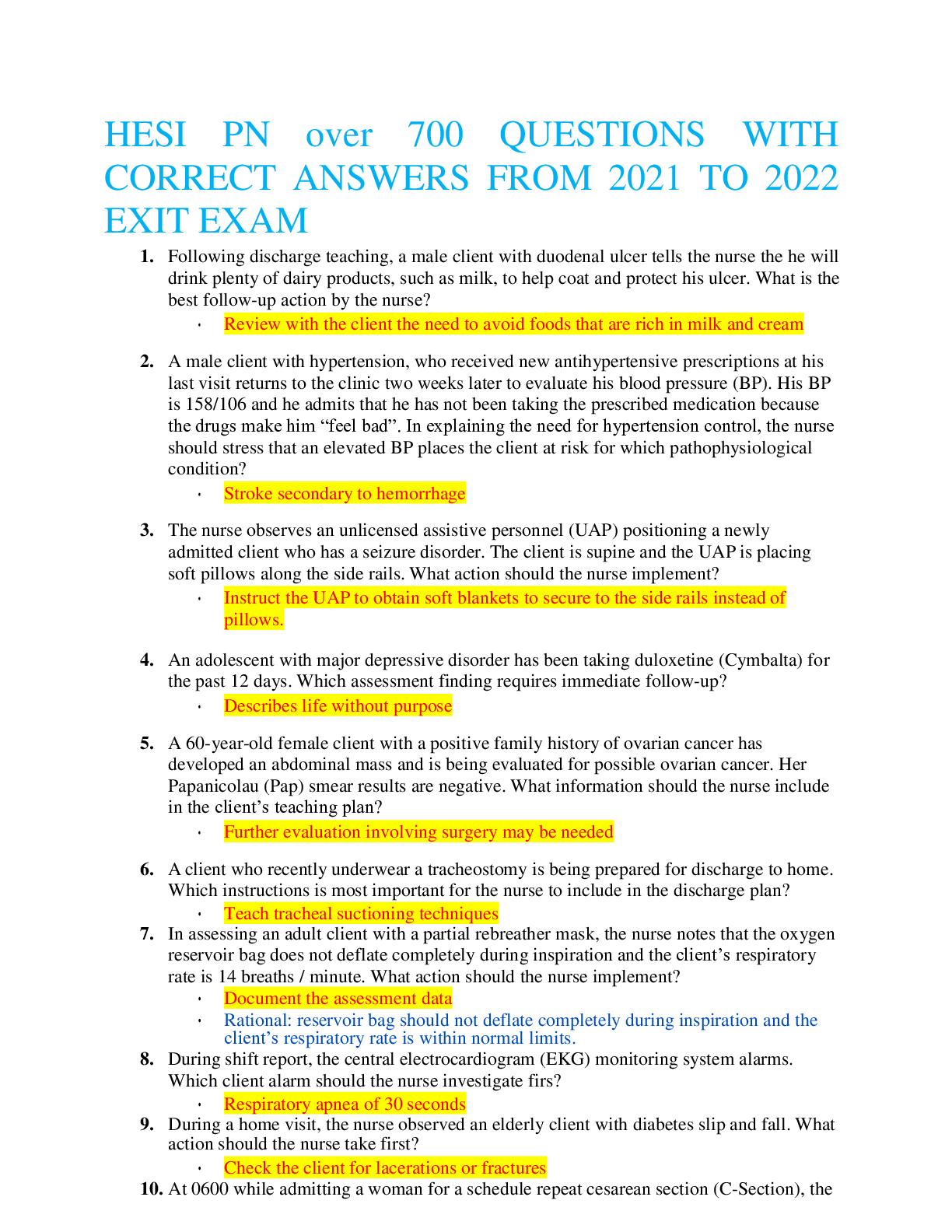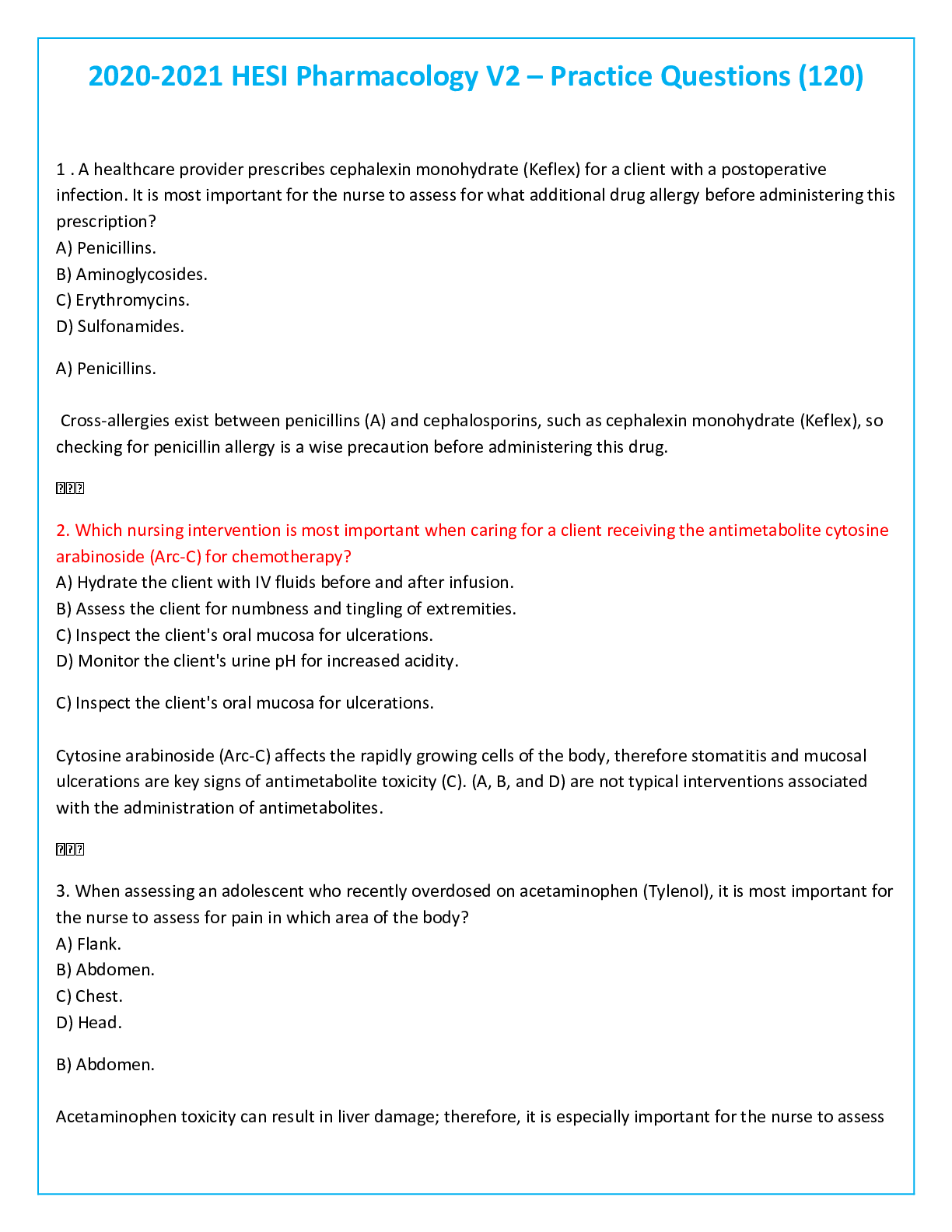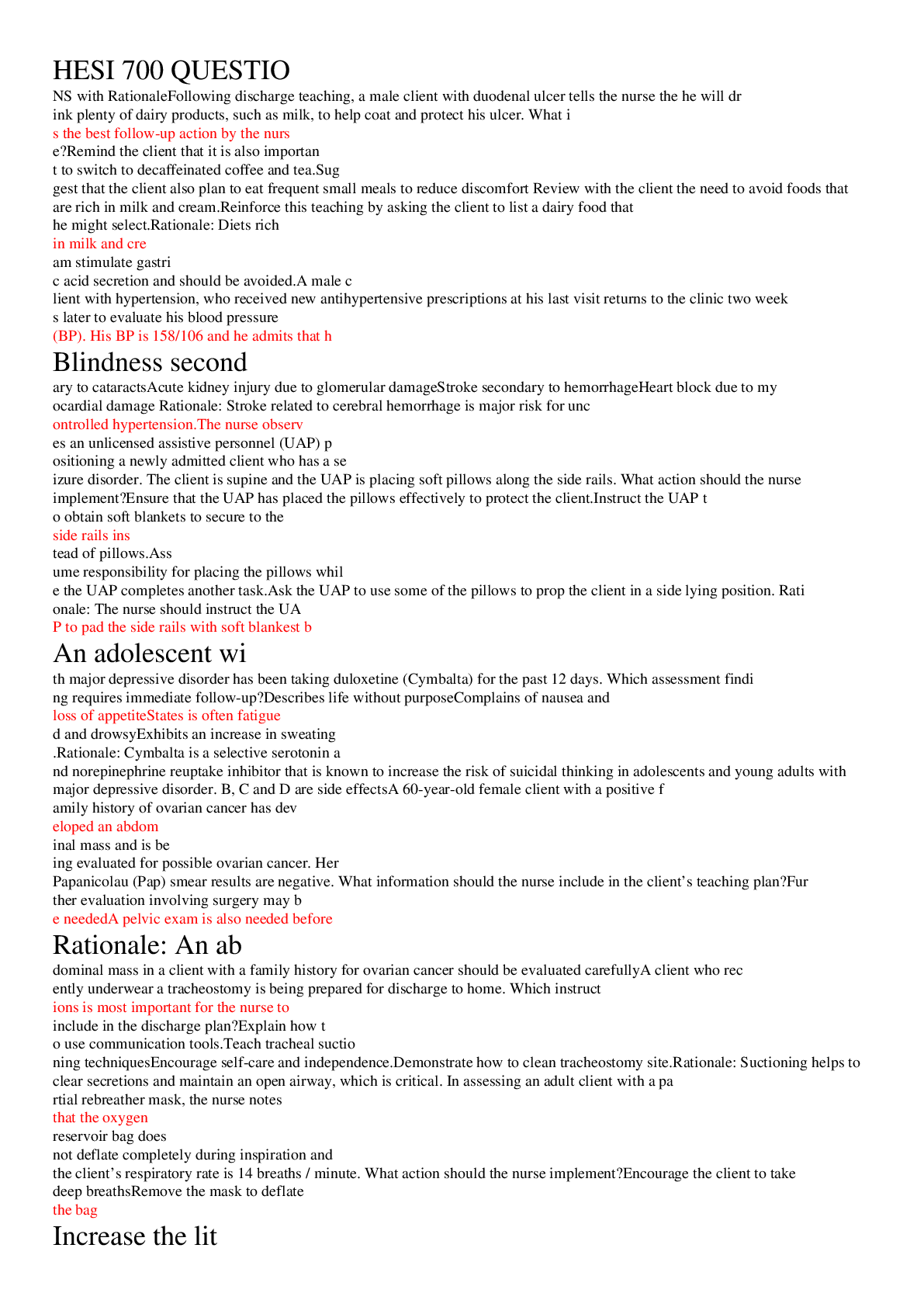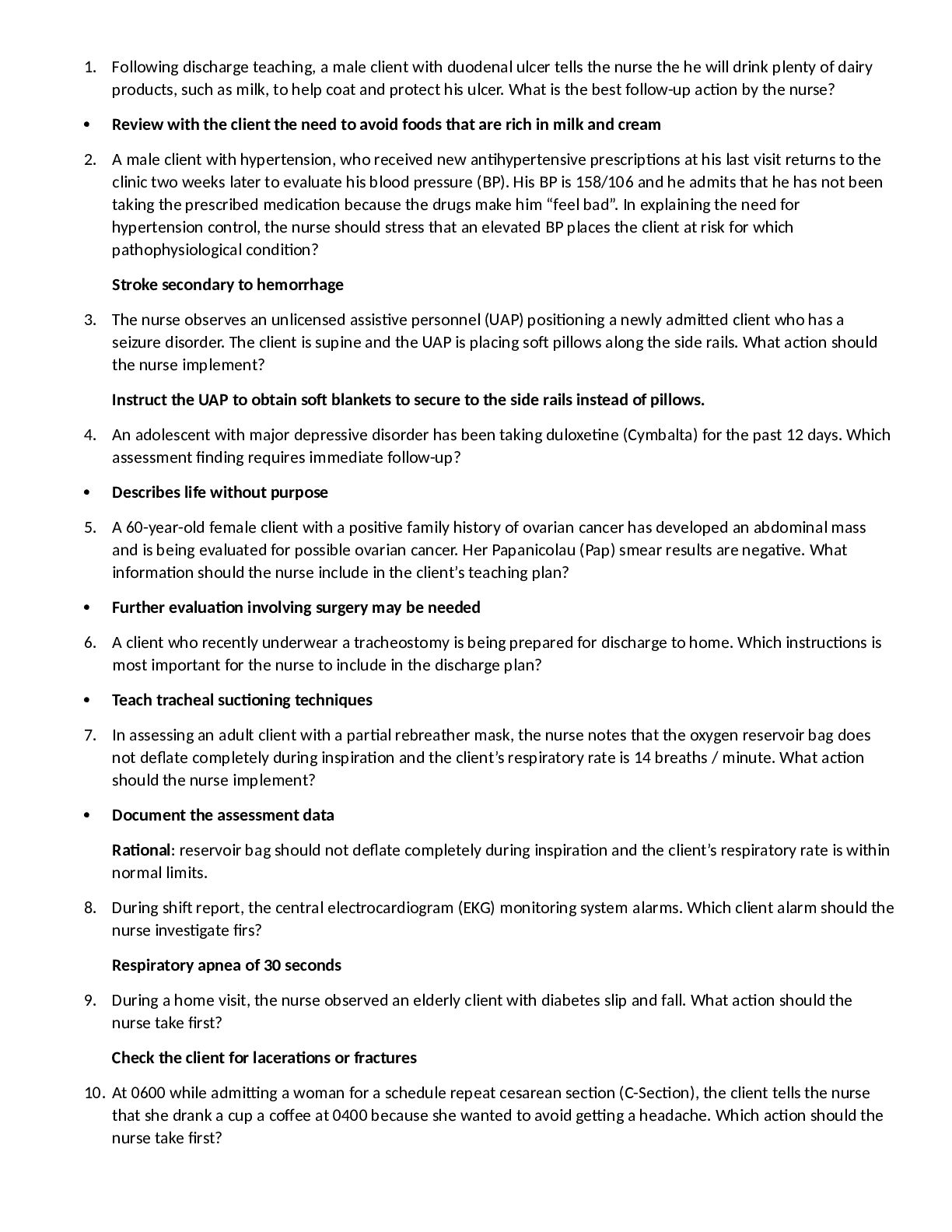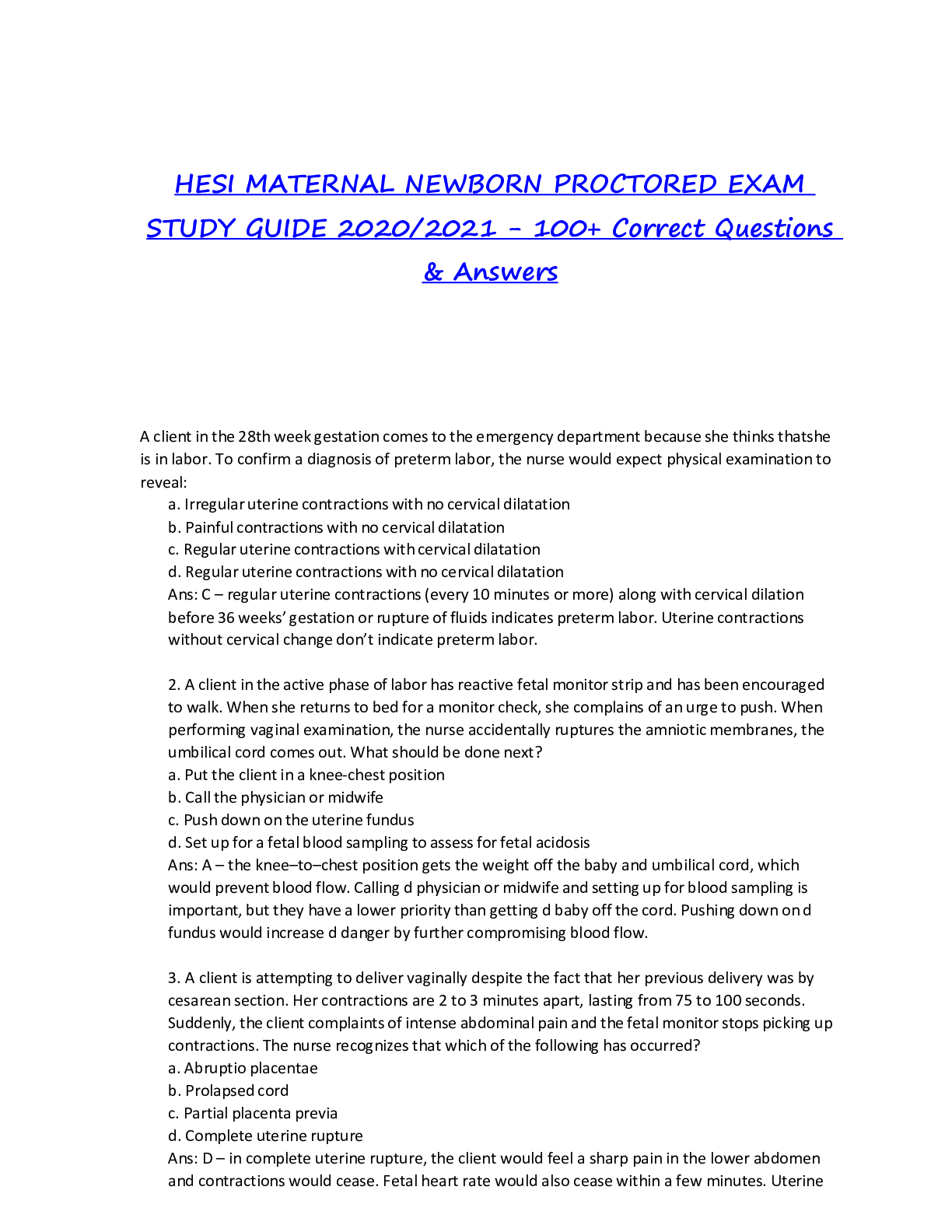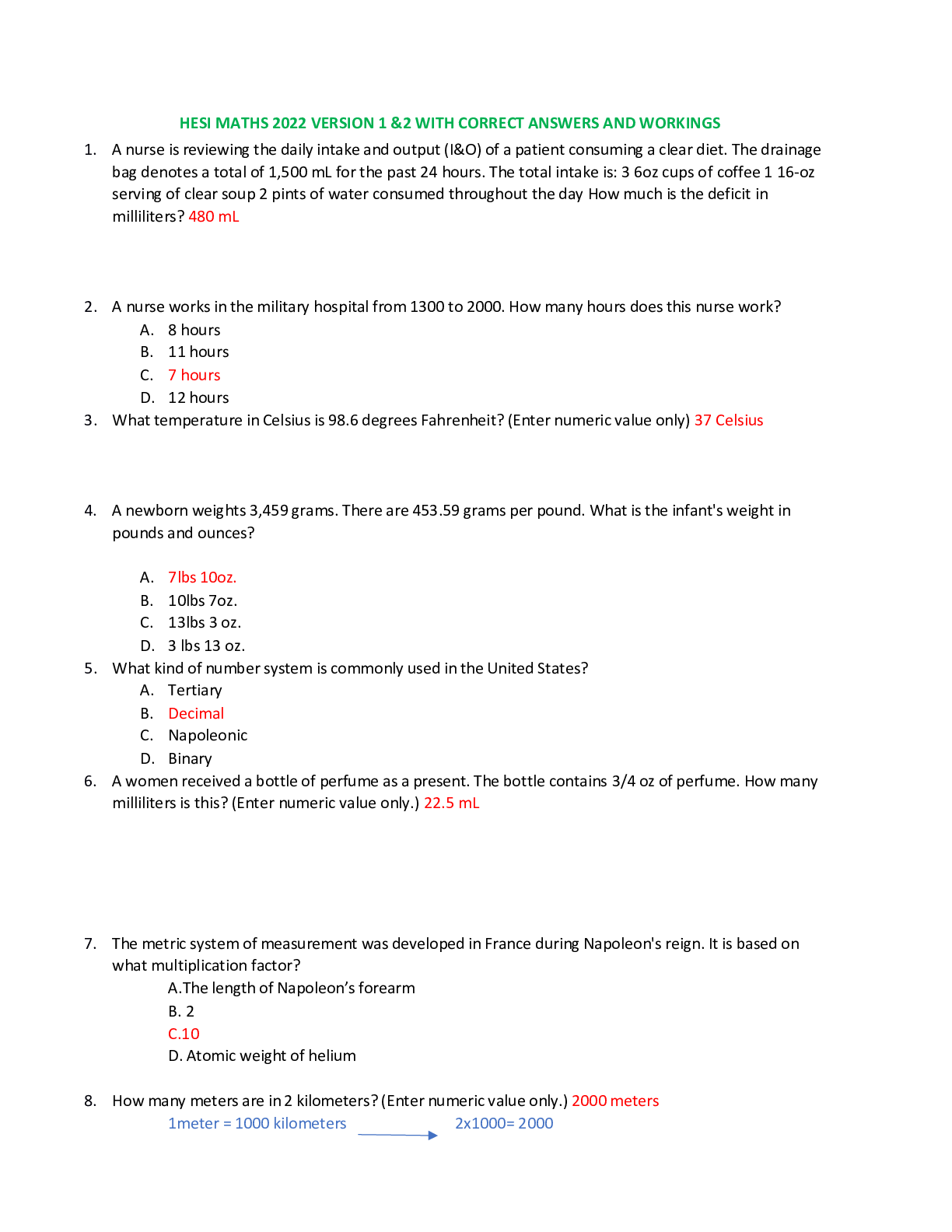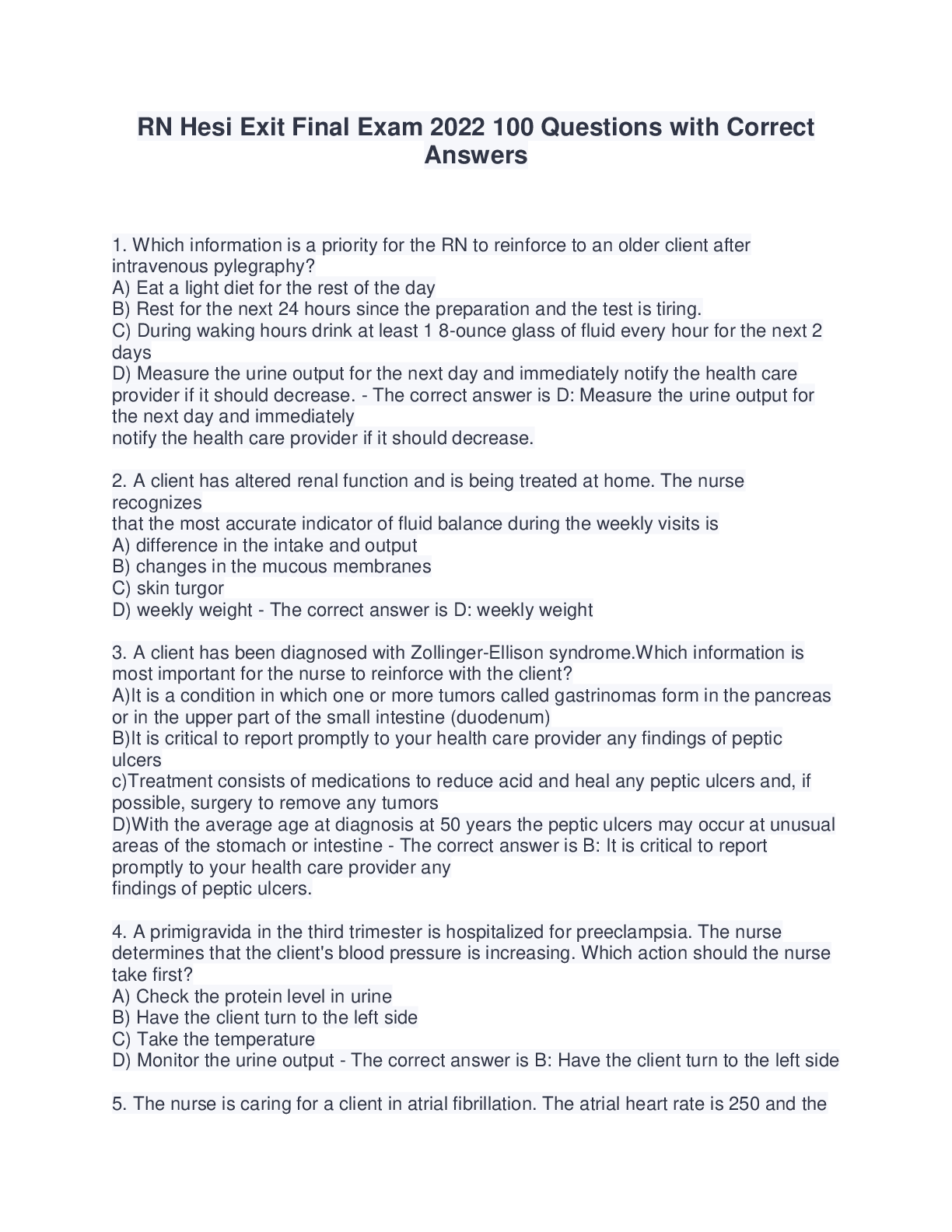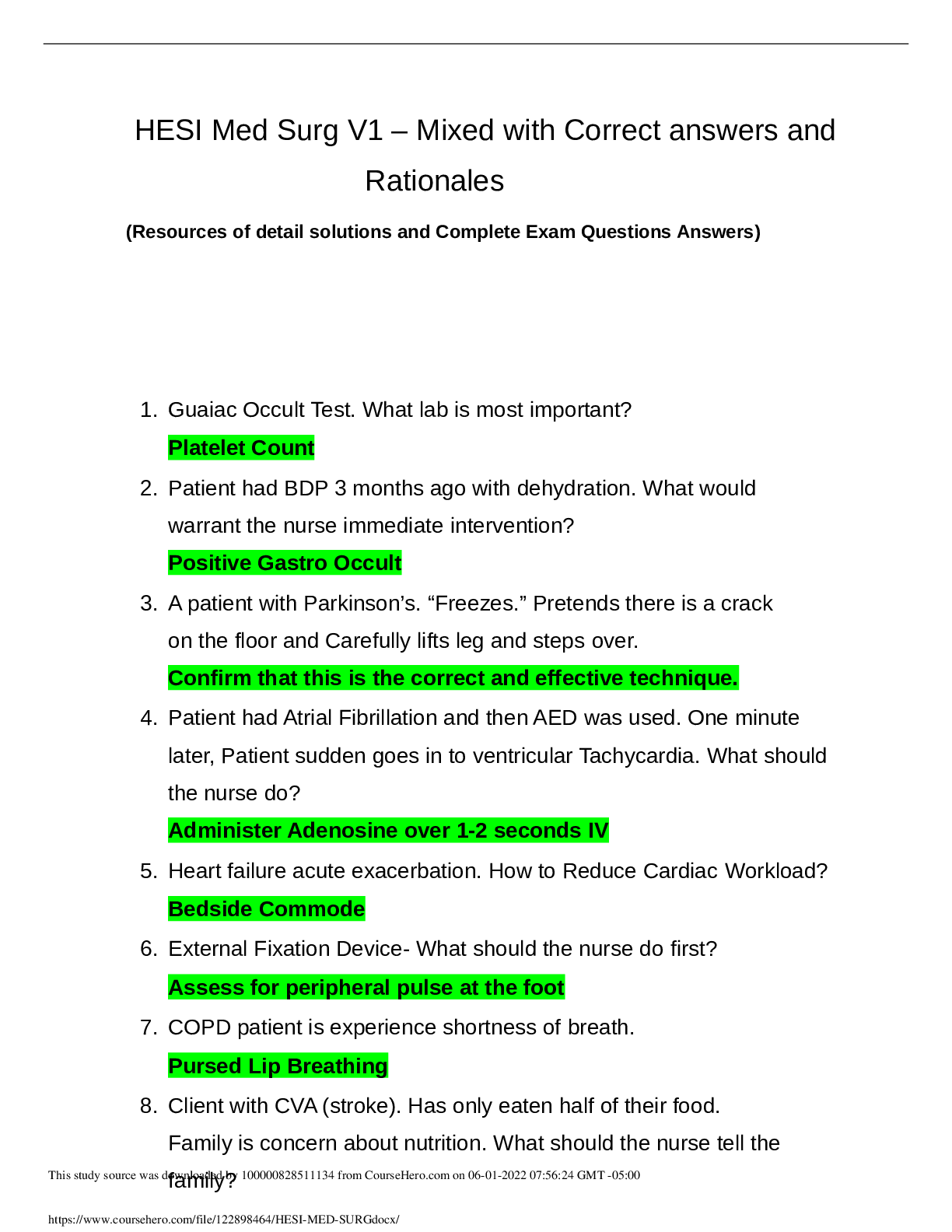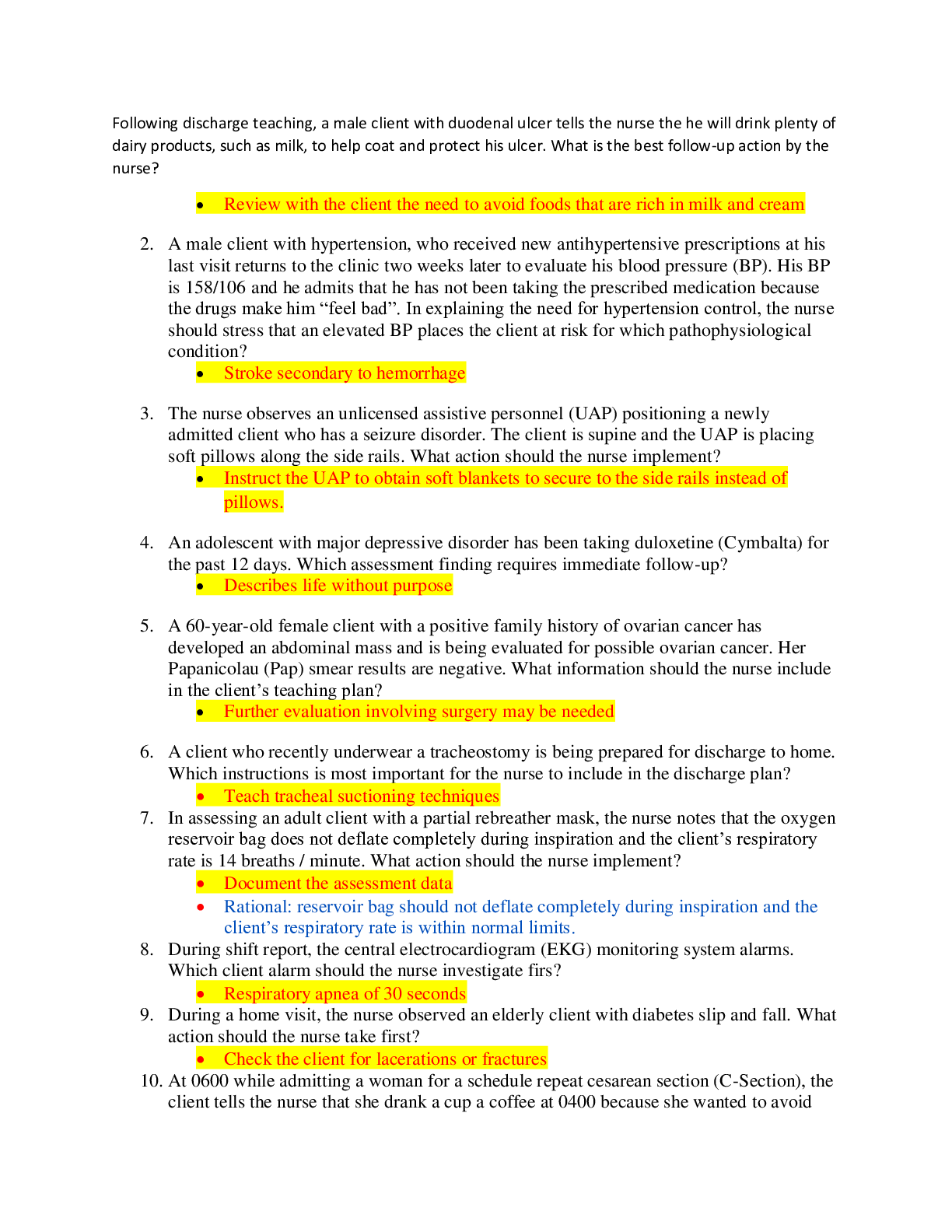*NURSING > HESI > HESI A2 Study Guide 2020 & 2021 HESI Study Guide Admission Assessment Exam Review 4th Edition & Prac (All)
HESI A2 Study Guide 2020 & 2021 HESI Study Guide Admission Assessment Exam Review 4th Edition & Practice Test Questions with Correct Answer Explanations]
Document Content and Description Below
HESI A2 Study Guide 2020 & 2021 HESI Study Guide Admission Assessment Exam Review 4th Edition & Practice Test Questions [Includes Detailed Answer Explanations] APEX Test Prep Table of Contents Test Ta... king Strategies FREE DVD OFFER Introduction to the HESI Admission Assessment Exam Math HESI Math Practice Questions Answer Explanations Reading Comprehension HESI Reading Practice Questions Answer Explanations Vocabulary HESI Vocabulary Practice Questions Answer Explanations Grammar HESI Grammar Practice Questions Answer Explanations Biology HESI Biology Practice Questions Answer Explanations Chemistry HESI Chemistry Practice Questions Answer Explanations Anatomy and Physiology HESI A&P Practice Questions Answer Explanations Physics HESI Physics Practice Questions Answer Explanations Introduction to the HESI Admission Assessment Exam Function of the Test The Health Education Systems, Inc. Admission Assessment Exam, also called the HESI A2, is an entrance exam used by nursing programs to help determine a candidate’s admission status. Most test takers are finishing up high school or are recent high school graduates seeking admission to a nursing program or other post-secondary health program. Each nursing program can set their own minimum passing scores that candidates must achieve to be granted admission to the program. Additionally, although there are ten potential sections or subtests of the HESI A2 (eight of which are academic subjects), nursing programs can select just a subset of these offerings, meaning that test takers may not need scores in all eight academic categories to be considered for admission. Test takers should check with the schools they are interested in applying to for an accurate list of the required HESI A2 section scores. The subtests that are not academic in nature include a learning style test and a personality test. Test Administration Applicants usually take the HESI A2 at the institution where they intend to apply. The test is administered online and while most schools that include the exam as part of their admissions process offer the exam at various times on- site, some Prometric test centers also offer administration of the HESI A2. Because many of the specifics of the exam administration are left to the discretion of each nursing program, the testing experience will vary at different testing institutions. For example, the cost for the exam, the available dates and times of administration, and the required sections are determined by each school. Additionally, some programs may allow candidates to retake the test or combine the highest scores achieved on the various subtests over multiple administrations to obtain the best composite scores, while other programs may prohibit retesting or may only accept scores obtained from one coherent session. Test takers are encouraged to inquire about all the testing specifics at each institution on their prospective application list. Accommodations for documented disabilities are usually permitted, though test takers should contact nursing programs directly to arrange for any necessary accommodations. Test Format The HESI A2 contains four major sections: English Language, Math, Science, and a Personality Profile. The English Language section consists of three 50-question sections: Reading Comprehension, Vocabulary & General Knowledge, and Grammar. The Math section also contains 50 questions. The Science section consists of four 25-question tests: Biology, Chemistry, Anatomy & Physiology, and Physics. The Personality Profile consists of a 15-question Personality Profile and a 14-question Learning Style assessment. Again, because each school or testing center can establish their own testing schedule and required sections, universal set time limits do not exist for the HESI A2. With that said, typically, test takers are allotted 5.25 hours total in cases where all ten sections are administered. The following chart summarizes the sections on the HESI A2: Scoring After a candidate completes the exam, he or she will receive a detailed score report as will the nursing program that administered the exam. The score report contains an explanation of the scoring process and scores for each of the subtests attempted. Scores are typically presented as a percentage of questions answered correctly; there is no penalty for incorrect answers, so test takers should not leave questions blank. As mentioned, each nursing program determines the minimum passing score for prospective students; there is no set passing score for the HESI A2. With that said, many RN programs establish a minimum score of 75%. Math Basic Operations with Whole Numbers Addition is the combining of two numbers to find the total. The numbers being added together are the addends, and the resulting answer is the sum. Addition problems can be completed using a variety of strategies including number lines, base-10 blocks, place value, and concrete models. When adding multi-digit numbers, the numbers must be lined up by place value vertically. The problem demonstrating this type of addition involving carrying is shown below: 1 318 4 7 1 8 5 The addition of the ones column , so the 5 is written beneath the ones column, and the 1 is carried over to be added to the tens column. The remaining columns are added down to provide the solution. When adding a negative number to a positive number, the problem becomes a subtraction problem. Adding 10 and -2 becomes . When adding two negative numbers, complete the addition as usual, but the resulting total is negative, . Subtraction involves taking away or removing an amount from a number to find the difference of the two values. Addition and subtraction are related because they are inverse operations. For example, the addition problem can be changed into a subtraction problem: . Subtraction problems also can be solved using some of the same methods as addition including number lines and concrete models. Subtracting multi-digit numbers is slightly more complicated because they can involve borrowing. An example of a subtraction problem with borrowing is shown below: 25613 - 5 6 2 0 7 In the ones column, 6 cannot be subtracted from 3; therefore, 1 is borrowed from the tens column making the ones column on the top row 13 instead of 3. The 6 in the tens column becomes 5 instead of 6. The rest of the subtraction is carried out accordingly. When a negative number is subtracted, it creates a double negative, . This changes the sign to a positive, . Multiplication is basically a short cut to repeated addition. For example, can be thought of as adding the number 4 a total of 5 times: . Both of these techniques yield the equivalent answer, 20. Another strategy for completing multiplication problems is to imagine sets of items being added together. One method to accomplish this is through the use of arrays. The following array represents . Other methods to complete multiplication problems include area models, partial products, and long multiplication like the example that follows: 23 × 14 213 × 1 4 9 2 The right column is multiplied first. In this case, so the 2 is written below the right column, and the 1 is carried. Next, the 4 in the right column is multiplied by the 2 in the left column, and the 1 that was carried in the previous step is added: . The result is placed to the left of the 2. 213 × 1 4 9 2 0 A 0 or blank space must be used for a placeholder before completing the next step of multiplication. 2 3 × 1 4 9 2 2 3 0 The next line of multiplication starts with the 1 in the left column. It is multiplied starting on the right by 3 and then by 2, with the results written below the appropriate columns as shown. 2 3 × 1 4 9 2 213 0 3 2 2 The two lines of multiplication are added together to achieve the final product of 322. When multiplying negative and nonnegative numbers, if the signs are the same, then the answer is positive. If the signs are different, then the answer is negative. These same rules apply to division as well. Like addition and subtraction, multiplication and division are inverse operations. Division splits an amount or number into equal groups or parts. For example, because 14 can be separated into 2 equal groups of 7. In the previous example, 14 is the dividend, 2 is the divisor, and 7 is the quotient, which is the term for the solution to a division problem. Division problems can be solved using arrays, area models, or equal groups of concrete objects. Division of multi-digit numbers can also be completed using long division, for example, . First, set up the problem. Start by dividing the first number on the left of the dividend, 3, by the divisor of 6. 3 is not divisible by 6, so the next number to the left in the dividend (the 3) comes into play. This means that 34 must be divided by 6. 6 will divide into 34 a total of 5 times, so the 5 goes above the 4. 6 multiplied by 5 equals 30, so write that below the 34. Then, subtract 30 from 34. This leaves 4. The next number to the right in the dividend must be dropped down to make 48. 48 is evenly divisible by 6, so put the quotient of that division, 8, on the top next to the 5. The final solution is 58. Operations follow certain properties and rules. Addition and multiplication follow the commutative property. This means that the numbers can be added or multiplied in any order, and the result will be the same. For example, and . Subtraction and division are not commutative. Addition and multiplication are also associative. The associative property means that the grouping of numbers with parentheses does not change the answer to the problem. For example, and . Another property that impacts operations is the distributive property. The distributive property states that when a sum or difference inside the parentheses is multiplied by a number, it is the same as multiplying both the numbers inside the parentheses by the outside number and adding or subtracting the results. For example: and When using operations and their properties, it is also important to remember the rule for the order of operations. When evaluating an expression, any operations inside grouping symbols must be completed first. Next, any numbers with exponents are simplified. Then, the multiplication and division portions of the expression can be evaluated. Addition and subtraction are to be completed last. A helpful mnemonic to remember these steps is Please Excuse My Dear Aunt Sally or PEMDAS. The following expression needs to be completed using the order of operations. The numbers inside the parentheses need to be evaluated first. This gives . Next, the multiplication must be completed, . Last, the addition is completed to provide a solution: Decimals Operations can be performed on rational numbers in decimal form. In this case, it is important to keep track of place value. To add decimals, make sure the decimal places are in alignment so that the numbers are lined up with their decimal points and add vertically. If the numbers do not line up because there are extra or missing place values in one of the numbers, then zeros may be used as placeholders. For example, becomes: Subtraction is done the same way. Multiplication and division are more complicated. To multiply two decimals, place one on top of the other as in a regular multiplication process and do not worry about lining up the decimal points. Then, multiply as with whole numbers, ignoring the decimals. Finally, in the solution, insert the decimal point as many places to the left as there are total digits to the right of the decimal in the original problem. Here is an example of a decimal multiplication: The answer to 0.67 times 0.4 is 0.268, and because there are three decimal values in the problem, the decimal point is positioned three units to the left in the answer. The decimal point plays an integral role throughout the whole problem when dividing with decimals. First, set up the problem in a long division format. If the divisor is not an integer, the decimal must be moved to the right as many units as needed to make it an integer. The decimal in the dividend must be moved to the right the same number of places to maintain equality. Then, division is completed normally. Here is an example of long division with decimals: Because the decimal point is moved two units to the right in the divisor of 0.06 to turn it into the integer 6, it is also moved two units to the right in the dividend of 12.72 to make it 1,272. The result of the division is 212, and remember that a division problem can always be checked by multiplying the answer by the divisor to see if the result is equal to the dividend. Fractions A rational number is a number that can be written in the form where and are integers, and is not equal to zero. In other words, rational numbers can be written in a fraction form. The value is the numerator, and is the denominator. If the numerator is equal to zero, the entire fraction is equal to zero. Non-negative fractions can be less than 1, equal to 1, or greater than 1. Fractions are less than 1 if the numerator is smaller (less than) than the denominator. For example, is less than 1. A fraction is equal to 1 if the numerator is equal to the denominator. For instance, is equal to 1. Finally, a fraction is greater than 1 if the numerator is greater than the denominator: the fraction is greater than 1. When the numerator is greater than the denominator, the fraction is called an improper fraction. An improper fraction can be converted to a mixed number, a combination of both a whole number and a fraction. To convert an improper fraction to a mixed number, divide the numerator by the denominator. Write down the whole number portion, and then write any remainder over the original denominator. For example, is equivalent to . Conversely, a mixed number can be converted to an improper fraction by multiplying the denominator times the whole number and adding that result to the numerator. Adding and Subtracting Fractions If a rational number is in fraction form, performing addition, subtraction, multiplication, and division is more complicated than when working with integers. First, consider addition. To add two fractions having the same denominator, add the numerators and then reduce the fraction. When an answer is a fraction, it should always be in lowest terms. Lowest terms means that every common factor between the numerator and denominator is divided out. For example: Both the numerator and denominator of have a common factor of 2, so 2 is divided out of each value to put the fraction in lowest terms. If denominators are different in an addition problem, the fractions must be converted to have common denominators. The least common denominator (LCD) of all the given denominators must be found, and this value is equal to the least common multiple (LCM) of the denominators. This non-zero value is the smallest number that is a multiple of both denominators. Then, rewrite each original fraction as an equivalent fraction using the new denominator. Once in this form, apply the process of adding with like denominators. For example, consider The LCD is 9 because it is the smallest multiple of both 3 and 9. The fraction must be rewritten with 9 as its denominator. Therefore, multiply both the numerator and denominator by 3. Multiplying by is the same as multiplying by 1, which does not change the value of the fraction. Therefore, an equivalent fraction is , and which is in lowest terms. Subtraction is performed in a similar manner; once the denominators are equal, the numerators are then subtracted. Multiplying and Dividing Fractions Common denominators are not used in multiplication and division. To multiply two fractions, multiply the numerators together and the denominators together. Then, write the result in lowest terms. For example: Alternatively, the fractions could be factored first to cancel out any common factors before performing the multiplication. For example: This second approach is helpful when working with larger numbers, as common factors might not be obvious. Multiplication and division of fractions are related because the division of two fractions is changed into a multiplication problem. Division of a fraction is equivalent to multiplication of the reciprocal of the second fraction, so that second fraction must be inverted, or “flipped,” to be in reciprocal form. For example: The fraction is the reciprocal of It is possible to multiply and divide numbers containing a mix of integers and fractions. In this case, convert the integer to a fraction by placing it over a denominator of 1. For example, a division problem involving an integer and a fraction is: Changing Fractions to Decimals Fractions can be converted to decimals. With a calculator, a fraction is converted to a decimal by dividing the numerator by the denominator. For example: Sometimes, rounding might be necessary. Consider: This decimal could be rounded for ease of use, and if it needed to be rounded to the nearest thousandth, the result would be 0.286. If a calculator is not available, a fraction can be converted to a decimal manually. First, find a number that, when multiplied by the denominator, has a value equal to 10, 100, 1,000, etc. Then, multiply both the numerator and denominator times that number. The decimal form of the fraction is equal to the new numerator with a decimal point placed as many place values to the left as there are zeros in the denominator. For example, to convert to a decimal, multiply both the numerator and denominator times 2, which results in The decimal is equal to 0.6 because there is one zero in the denominator, and so the decimal place in the numerator is moved one unit to the left. In the case where rounding would be necessary while working without a calculator, an approximation must be found. A number close to 10, 100, 1,000, etc. can be used. For example, to convert to a decimal, the numerator and denominator can be multiplied by 33 to turn the denominator into approximately 100, which makes for an easier conversion to the equivalent decimal. This process results in and an approximate decimal of 0.33. Once in decimal form, the number can be converted to a percentage. To do so, the decimal number is multiplied by 100 and then a percent sign is placed after the number. For example, 0.614 is equal to 61.4%. In other words, the decimal place is moved two units to the right and the percentage symbol is then added. Ratios and Proportions Fractions appear in everyday situations, and in many scenarios, they appear in the real-world as ratios and in proportions. A ratio is formed when two different quantities are compared. For example, in a group of 50 people, if there are 33 females and 17 males, the ratio of females to males is 33 to 17. This expression can be written in the fraction form, or by using the ratio symbol, 33:17. The order of the number matters when forming ratios. In the same setting, the ratio of males to females is 17 to 33, which is equivalent to or 17:33. A proportion is an equation involving two ratios. The equation or : = : is a proportion, for real numbers , , and . Usually, in one ratio, one of the quantities is unknown, and cross-multiplication is used to solve for the unknown. Consider To solve for , cross-multiply to obtain Divide each side by 4 to obtain the solution It is also true that percentages are ratios in which the second term is 100. For example, 65% is 65:100 or Therefore, when working with percentages, one is also working with ratios. Real-world problems frequently involve proportions. For example, consider the following problem: If 2 out of 50 pizzas are usually delivered late from a local Italian restaurant, how many would be late out of 235 orders? The following proportion would be solved representing the unknown quantity of late pizzas: Cross multiplying results in . Dividing both sides by 50 yields which in lowest terms is equal to In decimal form, this improper fraction is equal to 9.4. Because it does not make sense to answer this question with decimals (portions of pizzas do not get delivered) the answer must be rounded. Traditional rounding rules would say that 9 pizzas would be expected to be delivered late. However, to be safe, rounding up to 10 pizzas out of 235 would probably make more sense given the context of this problem. Recall that a ratio is the comparison of two different quantities. Comparing 2 apples to 3 oranges results in the ratio 2:3, which can be expressed as the fraction Many real-world problems involve ratios. Often, problems with ratios involve proportions, as when two ratios are set equal to find the missing amount. However, some problems involve deciphering single ratios. For example, consider an amusement park that sold 345 tickets last Saturday. If 145 tickets were sold to adults and the rest of the tickets were sold to children, what was the ratio of the number of adult tickets to children’s tickets sold? A common mistake would be to say the ratio is 145:345. However, 345 is the total number of tickets sold. There were 345 – 145 = 200 tickets sold to children. The correct ratio of adult to children’s tickets is 145:200. As a fraction, this expression is written as which can be reduced to Rate of change problems involve calculating a ratio of a quantity per some unit of measurement. Usually the unit of measurement is time. For example, meters per second is a common rate of change. To calculate this measurement, find the amount traveled in meters and divide by total time traveled. The calculation is an average of the speed over the entire time interval. Another common rate of change used in the real world is miles per hour. Consider the following problem that involves calculating an average rate of change in temperature. Last Saturday, the temperature at 1:00 a.m. was 34 degrees Fahrenheit, and at noon, the temperature had increased to 75 degrees Fahrenheit. What was the average rate of change over that time interval? The average rate of change is calculated by finding the change in temperature and dividing by the total hours elapsed. Therefore, the rate of change was equal to: degrees per hour This quantity rounded to two decimal places is equal to 3.72 degrees per hour. Percentages As discussed previously, percentages are defined to be parts per one hundred. To convert a decimal to a percentage, the decimal point is moved two units to the right and the percent sign is placed after the number. Percentages appear in many scenarios in the real world. It is important to make sure the statement containing the percentage is translated to a correct mathematical expression. Be aware that it is extremely common to make a mistake when working with percentages within word problems. An example of a word problem containing a percentage is the following: 35% of people speed when driving to work. In a group of 5,600 commuters, how many would be expected to speed on the way to their place of employment? The answer to this problem is found by finding 35% of 5,600. To do this, first, change the percentage to the decimal 0.35. Then, compute the product: Therefore, it would be expected that 1,960 of those commuters would speed on their way to work based on the data given. In this situation, the word “of” signals to use multiplication to find the answer. Another way percentages are used is in the following problem: Teachers work 8 months out of the year. What percent of the year do they work? To answer this problem, find what percent of 12 the number 8 is, because there are 12 months in a year. Therefore, divide 8 by 12, and convert that number to a percentage: The percentage rounded to the nearest tenth place tells us that teachers work of the year. Percentages also appear in real-world application problems involving finding missing quantities like in the following question: 60% of what number is 75? To find the missing quantity, an equation can be used. Let be equal to the missing quantity. Therefore, Divide each side by 0.60 to isolate the variable. This yields . Therefore, 60% of 125 is equal to 75. Sales tax is an important application relating to percentages because tax rates are usually given as percentages. For example, a city might have an 8% sales tax rate. Therefore, when an item is purchased with that tax rate, the real cost to the customer is 1.08 times the price listed in the store. For example, a $25 pair of jeans costs the customer Sales tax rates can also be determined if they are unknown when an item is purchased. If a customer visits a store and purchases an item for $21.44, but the price in the store was $19, the tax rate can be found by first subtracting $21.44 – $19 to obtain $2.44, the sales tax amount. The sales tax is a percentage of the in-store price. Therefore, the tax rate is which has been rounded to the nearest thousandths place. In this scenario, the actual sales tax rate given as a percentage is 12.8%. 12-Hour Clock versus Military Time There are two different methods of telling time. The first is the 24-hour clock, or what is sometimes called military time. This method is shown in the format hours:minutes. The current time is the number of hours and minutes past midnight. The other main way of telling time is the use of the 12-hour clock or the AM/PM system. This takes the 24 hours in a day and divides it into the nighttime hours, which run from midnight to noon, and the daytime hours, which run from noon to midnight. The hours from midnight to noon are the AM hours, and the hours from noon to midnight are the PM hours. Rather than counting up to 24, this method counts from 1 to 12 twice in one day. To convert between the two methods, the other important piece of information to know is that the first hour of the day in the 24-hour clock is midnight, which would read 0:00. For the AM hours starting at 1:00 AM, the two methods will yield the same time. 2:30 AM on the 12-hour clock will be the same as 2:30 in military time. However, between midnight and 1:00 AM on the 12-hour clock, 12 hours must be subtracted to convert between the two methods. For example, if it is 12:35 AM in the 12-hour clock system, then subtract 12 hours to get 00:35 hours in military time. Conversely, if it is after noon, add 12 hours to the 12-hour clock time to get the military time. For example, if it is 3:15 PM by the 12-hour clock, add 12 hours to get 15:15 in military time. Algebra An equation in one variable is a mathematical statement where two algebraic expressions in one variable, usually , are set equal. To solve the equation, the variable must be isolated on one side of the equals sign. The addition and multiplication principles of equality are used to isolate the variable. The addition principle of equality states that the same number can be added to or subtracted from both sides of an equation. Because the same value is being used on both sides of the equals sign, equality is maintained. For example, the equation is equivalent to both: This principle can be used to solve the following equation: The variable must be isolated, so to move the 5 from the left side, subtract 5 from both sides of the equals sign. Therefore: So, the solution is This process illustrates the idea of an additive inverse because subtracting 5 is the same as adding -5. Basically, add the opposite of the number that must be removed to both sides of the equals sign. The multiplication principle of equality states that equality is maintained when a number is either multiplied by both expressions on each side of the equals sign, or when both expressions are divided by the same number. For example, is equivalent to both and Multiplying both sides by 4 and dividing both sides by 4 maintains equality. Solving the equation requires the use of both principles. First, the addition principle is applied by adding 18 to both sides of the equals sign, which results in Then the multiplication principle is used to divide both sides by 6, giving the solution Using the multiplication principle in the solving process is the same as involving a multiplicative inverse. A multiplicative inverse is a value that, when multiplied by a given number, results in 1. Dividing by 6 is the same as multiplying by , which is both the reciprocal and multiplicative inverse of 6. When solving a linear equation in one variable, checking the answer shows if the solution process was performed correctly. Plug the solution into the variable in the original equation. If the result is a false statement, something was done incorrectly during the solution procedure. Checking the example above gives the following: Therefore, the solution is correct. Some equations in one variable involve fractions or the use of the distributive property. In either case, the goal is to obtain only one variable term and then use the addition and multiplication principles to isolate that variable. Consider the equation To solve for , multiply each side of the equation by the reciprocal of which is This step results in which simplifies into the solution Now consider the equation: The distributive property can be used to clear the parentheses. Therefore, each term inside the parentheses is multiplied by 3. This step results in: Next, like terms are collected on the left-hand side. Like terms are terms with the same variable or variables raised to the same exponent(s). Only like terms can be combined through addition or subtraction. After collecting like terms, the equation is: Finally, the addition and multiplication principles are applied. is added to both sides to obtain: Then, 1 is subtracted from both sides to obtain Finally, both sides are divided by 6 to obtain the solution Two other types of solutions can be obtained when solving an equation in one variable. The final result could be that there is either no solution or that the solution set contains all real numbers. Consider the equation: First, the like terms can be combined on the right to obtain: Next, is subtracted from both sides. This step results in the false statement There is no value that can be plugged into that will ever make this equation true. Therefore, there is no solution. The solution procedure contained correct steps, but the result of a false statement means that no value satisfies the equation. The symbolic way to denote that no solution exists is Next, consider the equation: Combining the like terms on both sides results in: The left-hand side is exactly the same as the right-hand side. Using the addition principle to move terms, the result is which is always true. Therefore, the original equation is true for any number, and the solution set is all real numbers. The symbolic way to denote such a solution set is , or in interval notation, One-step problems take only one mathematical step to solve. For example, solving the equation is a one-step problem because the one step of dividing both sides of the equation by 5 is the only step necessary to obtain the solution The multiplication principle of equality is the one step used to isolate the variable. The equation is of the form , where and are rational numbers. Similarly, the addition principle of equality could be the one step needed to solve a problem. In this case, the equation would be of the form or for real numbers and . A multi-step problem requires more than one step to find the solution, or it could consist of solving more than one equation. An equation that involves both the addition principle and the multiplication principle is a two-step problem, and an example of such an equation is Solving involves adding 4 to both sides and then dividing both sides by 2. An example of a two-step problem involving two separate equations is The two equations form a system of two equations that must be solved together in two variables. The system can be solved by the substitution method. is already solved for in terms of , plug in for into the equation resulting in Therefore, and Because there are two variables, the solution consists of both a value for and for . To solve for y, is substituted into either original equation. The easiest choice is Therefore: The solution can be written as the ordered pair Real-world problems can be translated into both one-step and multi-step problems. In either case, the word problem must be translated from the verbal form into mathematical expressions and equations that can be solved using algebra. An example of a one-step real-world problem is the following: A cat weighs half as much as a dog living in the same house. If the dog weighs 14.5 pounds, how much does the cat weigh? To solve this problem, an equation can be used. In any word problem, the first step must be defining variables that represent the unknown quantities. For this problem, let be equal to the unknown weight of the cat. Because two times the weight of the cat equals 14.5 pounds, the equation to be solved is: Use the multiplication principle to divide both sides by 2. Therefore, The cat weighs 7.25 pounds. Most of the time, real-world problems are more difficult than this one and consist of multi-step problems. The following is an example of a multi-step problem: The sum of two consecutive page numbers is equal to 437. What are those page numbers? First, define the unknown quantities. If is equal to the first page number, then is equal to the next page number because they are consecutive integers. Their sum is equal to 437, and this statement translates to the equation: To solve, first collect like terms to obtain: Then, subtract 1 from both sides and then divide by 2. The solution to the equation is Therefore, the two consecutive page numbers that satisfy the problem are 218 and 219. It is always important to make sure that answers to real-world problems make sense. For instance, if the solution to this same problem resulted in decimals, that should be a red flag indicating the need to check the work. Page numbers are whole numbers; therefore, if decimals are found to be answers, the solution process should be double- checked to see where mistakes were made. When presented with a real-world problem that must be solved, the first step is always to determine what the unknown quantity is that must be solved for. Use a variable, such as or , to represent that unknown quantity. Sometimes there can be two or more unknown quantities. In this case, either choose an additional variable, or if a relationship exists between the unknown quantities, express the other quantities in terms of the original variable. After choosing the variables, form algebraic expressions and/or equations that represent the verbal statement in the problem. The following table shows examples of vocabulary used to represent the different operations. The combination of operations and variables form both mathematical expression and equations. The difference between expressions and equations are that there is no equals sign in an expression, and that expressions are evaluated to find an unknown quantity, while equations are solved to find an unknown quantity. Measurement and Roman Numerals When working with dimensions, sometimes the given units don’t match the formula, and conversions must be made. The metric system has base units of meter for length, kilogram for mass, and liter for liquid volume. This system expands to three places above the base unit and three places below. These places correspond with prefixes with a base of 10. The following table shows the conversions: To convert between units within the metric system, values with a base ten can be multiplied. The decimal can also be moved in the direction of the new unit by the same number of zeros on the number. For example, 3 meters is equivalent to .003 kilometers. The decimal moved three places (the same number of zeros for kilo-) to the left (the same direction from base to kilo-). Three meters is also equivalent to 3,000 millimeters. The decimal is moved three places to the right because the prefix milli- is three places to the right of the base unit. The English Standard system used in the United States has a base unit of foot for length, pound for weight, and gallon for liquid volume. These conversions aren’t as easy as the metric system because they aren’t a base ten model. The following table shows the conversions within this system: When converting within the English Standard system, most calculations include a conversion to the base unit and then another to the desired unit. For example, take the following problem: . There is no straight conversion from quarts to cups, so the first conversion is from quarts to pints. There are 2 pints in 1 quart, so there are 6 pints in 3 quarts. This conversion can be solved as a proportion: It can also be observed as a ratio 2:1, expanded to 6:3. Then the 6 pints must be converted to cups. The ratio of pints to cups is 1:2, so the expanded ratio is 6:12. For 6 pints, the measurement is 12 cups. This problem can also be set up as one set of fractions to cancel out units. It begins with the given information and cancels out matching units on top and bottom to yield the answer. Consider the following expression: It’s set up so that units on the top and bottom cancel each other out: The numbers can be calculated as on the top and 1 on the bottom. It still yields an answer of 12 This process of setting up fractions and canceling out matching units can be used to convert between standard and metric systems. A few common equivalent conversions are 2.54 cm = 1 inch, 3.28 feet = 1 meter, and 2.205 pounds = 1 kilogram. Writing these as fractions allows them to be used in conversions. For the fill-in-the-blank problem 5 meters = feet, an expression using conversions starts with the expression , where the units of meters will cancel each other out, and the final unit is feet. Calculating the numbers yields 16.4 feet. This problem only required two fractions. Others may require longer expressions, but the underlying rule stays the same. When there’s a unit on the top of the fraction that’s the same as the unit on the bottom, then they cancel each other out. Using this logic and the conversions given above, many units can be converted between and within the different systems. The conversion between Fahrenheit and Celsius temperature is found in a formula: For example, to convert to Celsius, the given temperature would be entered into the formula: Solving the equation, the temperature comes out to be . To convert in the other direction, the formula becomes: Remember the order of operations when calculating these conversions. Roman numerals are sometimes used in place of Arabic numbers. The Roman numeral system uses different letter combinations to represent numbers. Seven letters are utilized in this system. The chart below shows the more common numerals and what number they indicate: There are rules for the different combinations. When a symbol comes after a symbol for a larger number, it is added to the larger symbol. If a symbol appears before a symbol or a larger number, then it should be subtracted. For example, XXXIV represents 34 because . For larger Roman numerals, a dash is added to the top of the symbol that indicates times 1,000. For example, equals 10,000 because . Helpful Information to Memorize In addition to the list of Roman Numerals, measurement conversions, and formulas presented in the previous sections, prepared test takers commit to memory several key mathematical formulas. Questions in the Math section of the HESI A2 may require knowledge of certain formulas in order to correctly obtain the answer. Other questions can be answered much more quickly if conversions that can be calculated out are instead readily available in stored memory. Time saved by not having to perform calculations to obtain an answer can be allocated to more difficult questions that may otherwise not receive ample time to solve. For example, it is common to encounter a fraction, such as 2/5, that must be converted to a decimal or percentage. Instead of calculating the answer by hand or via calculator, test takers who have committed to memory these conversions for basic values such as this one, can automatically select the correct answer of 0.40 or 40% and then quickly move on the next question. In addition to temperature conversions, Roman Numerals, and the common measurements previously listed, the following simple equivalencies should be memorized for a better experience on test day: HESI Math Practice Questions 1. a. 14.91 b. 14.01 c. 15.01 d. 5.01 2. a. 28.035 b. 5.607 c. 280.35 d. 28.025 3. a. 833 b. 933 c. 924 d. 856 4. a. 38 b. 36 c. 39 d. 49 5. Which of the following expressions best exemplifies the distributive property? a. b. c. d. 6. a. 30 b. 16 c. 64 d. 62 7. a. 21 b. 18 c. -21 d. -18 8. What is converted to a percentage? a. 0.20 b. 20% c. 25% d. 12% 9. Which of the following is the correct decimal form of the fraction rounded to the nearest hundredth place? a. 0.420 b. 0.42 c. 0.424 d. 0.140 10. What is 1.56 converted to a simplified fraction? a. b. c. d. 11. Which of the following represents the correct sum of and ? a. b. c. d. 12. What is the product of and a. b. c. d. 13. What is the result of dividing by ? a. b. c. d. 14. Subtract from Which of the following is the correct result? a. b. 0 c. d. 15. A jar is filled with green, yellow, and orange marbles. If of the marbles are green and are yellow, what fraction of the marbles are orange? a. b. c. d. 16. What is the solution to the equation ? a. b. No solution c. d. All real numbers 17. What is the solution to the equation ? a. b. No solution c. d. All real numbers 18. Which of the following is the result when solving the equation a. Any real number is a solution. b. There is no solution. c. is the solution. d. is the solution. 19. How many cases of cola can Lexi purchase if each case is $3.50 and she has $40? a. 10 b. 12 c. 11.4 d. 11 20. Two consecutive integers exist such that the sum of three times the first and two less than the second is equal to 411. What are those integers? a. 103 and 104 b. 104 and 105 c. 102 and 103 d. 100 and 101 21. In a neighborhood, 15 out of 80 of the households have children under the age of 18. What percentage of the households have children? a. 0.1875% b. 18.75% c. 1.875% d. 15% 22. Gina took an algebra test last Friday. There were 35 questions, and she answered 60% of them correctly. How many correct answers did she have? a. 35 b. 20 c. 21 d. 25 23. Paul took a written driving test, and he got 12 of the questions correct. If he answered 75% of the total questions correctly, how many problems were on the test? a. 25 b. 16 c. 20 d. 18 24. If a car is purchased for $15,395 with a 7.25% sales tax, how much is the total price? a. $15,395.07 b. $16,511.14 c. $16,411.13 d. $15,402 25. Bindee is having a barbeque on Sunday and needs 12 packets of ketchup for every 5 guests. If 60 guests are coming, how many packets of ketchup should she buy? a. 100 b. 12 c. 144 d. 60 26. A grocery store sold 48 bags of apples in one day, and 9 of the bags contained Granny Smith apples. The rest contained Red Delicious apples. What is the ratio of bags of Granny Smith to bags of Red Delicious that were sold? a. 48:9 b. 39:9 c. 9:48 d. 9:39 27. If Oscar’s bank account totaled $4,000 in March and $4,900 in June, what was the rate of change in his bank account total over those three months? a. $900 a month b. $300 a month c. $4,900 a month d. $100 a month 28. How many kiloliters are in 6 liters? a. 6,000 b. 600 c. 0.006 d. 0.0006 29. How many centimeters are in 3 feet? (Note: 2.54cm = 1 inch) a. 0.635 b. 91.44 c. 14.17 d. 7.62 30. If Sandy can bike 8 miles in 25 minutes, how many miles can she bike in 55 minutes? a. 17.6 miles b. 16 miles c. 16.9 miles d. 17.3 miles 31. What is 17:53 in military time converted to standard time? a. 5:53 PM b. 5:53 AM c. 7:53 AM d. 7:53 PM 32. What is 3:35 PM converted to military time? a. 13:35 b. 15:35 c. 9:35 d. 5:35 33. A nurse arrives at work at 18:00 for a 10-hour shift. What time does her shift end? a. 6 PM b. 6 AM c. 2 AM d. 4 AM 34. What is the solution to the following system of equations? a. (4, 2) b. (3, 4) c. (2, 4) d. (2, 6) 35. What algebraic expression represents the following phrase? The sum of nine and the product of 3 and a number x. a. b. c. d. 36. Emma bought four notebooks at $2.50 each and 3 boxes of pencils at $1.35 each. If she gave the cashier a $20 bill, how much change should she receive? a. $7.30 b. $5.95 c. $3.45 d. $14.05 37. A patient has been instructed to drink a gallon of water each day. How many cups does the patient need to drink? a. 16 cups b. 8 cups c. 24 cups d. 12 cups 38. The temperature at Sam’s house was 95°F. What was the temperature in Celsius? a. 63°C b. 113°C c. 20°C d. 35°C 39. When the temperature reaches 100°F, the children at the local pool must get out. The current temperature is 30°C. How many °F can the temperature climb before the children must get out? a. 37 b. 86 c. 14 d. 8 40. The number 1236 is equivalent to which Roman numeral? a. MCXXXVI b. MCCXXVI c. MCCXXXVI d. MCCXXXIV 41. The Roman numeral CCLIX is equivalent to which Arabic number? a. 259 b. 2059 c. 2509 d. 2511 42. a. 19.45 b. 19.261 c. 20.261 d. 19.36 43. Andrea has 6 black shirts, 8 white shirts, 5 red shirts, 4 blue shirts, and 7 gray shirts. If 40% of her shirts have long sleeves, how many have short sleeves? a. 12 b. 18 c. 19 d. 16 44. There are 99 boys per every 3 grade levels at a local high school. How many boys are there in 7 grade levels? a. 297 b. 252 c. 226 d. 231 45. A jewelry store sells bracelets, necklaces, rings, and earrings. Each type of jewelry has several models. The number of models and sales amount per day are listed in the following table: How many pieces of jewelry are sold in a day? a. 20 b. 97 c. 22 d. 107 46. Using the table from the previous question, what is the ratio of total necklaces sold to total earrings sold? a. 5:5 b. 24:40 c. 25:40 d. 5:8 47. Jennifer makes $14.65 an hour and 20% of each sale she makes as her commission. If she works for 8 hours and makes a total of $273.20 in a day, what were her total sales for the day? a. $54.64 b. $780 c. $156 d. $586 48. b. c. d. 49. What is the value of y in the following equation, if ? a. 20 b. -28 c. 44 d. 32 50. 12 is what percentage of 80? a. 12% b. 8% c. 15% d. 6% Answer Explanations 1. C: The first step is to line the decimal points up, and then add the numbers vertically. 101.612 4 . 3 9 1 5 . 0 1 2. A: To complete this problem, first remove the decimals. Next, complete the multiplication to find the product, 28,035. Because there are three decimal places in the original problem, the decimal needs to be placed three places to the left. This gives a solution of 28.035. 3. B: The numbers must be lined up so that the place value lines up vertically. Then, subtract accordingly. - 356 933 4. C: The division problem is completed as follows. 5. D: The distributive property is used when a number is being multiplied by a term or terms inside of parentheses. The number outside the parentheses is multiplied, or distributed, to each term, and the results are added or subtracted as called for. 6. D: To solve this expression, the order of operations must be used. The first step is to evaluate what is inside the parentheses: Next, the multiplication and division should be completed: The last step is to subtract, . 7. B: The rule of negative numbers states that if two negative numbers are multiplied together, the resulting product is positive. Therefore: Then, 54 can be divided by 3 to find the answer of 18. 8. B: The fraction can be reduced to , in lowest terms. First, it must be converted to a decimal. Dividing 1 by 5 results in 0.2. Then, to convert to a percentage, move the decimal point two units to the right and add the percentage symbol. The result is 20%. 9. B: If a calculator is used, divide 33 into 14 and keep two decimal places. If a calculator is not used, multiply both the numerator and denominator by 3. This results in the fraction and hence a decimal of 0.42. 10. C: The decimal portion of 1.56 must be placed over 100 which yields . However, this can be further simplified. The fraction portion can be reduced by a factor of 4. The result is . 11. B: Common denominators must be used. The LCD is 15, and Therefore, , and in lowest terms, the answer is A common factor of 5 was divided out of both the numerator and denominator. 12. A: A product is found by multiplication. Multiplying two fractions together is easier when common factors are cancelled first to avoid working with larger numbers. 13. D: Division is completed by multiplying by the reciprocal. Therefore: 14. C: Common denominators must be used. The LCD is 168, so each fraction must be converted to have 168 as the denominator. 15. B: The total fraction of green and yellow marbles is: The fraction of orange marbles is: 16. A: First, the distributive property must be used on the left side. This results in: The addition property is then used to add 5 to both sides, and then to subtract from both sides, resulting in Finally, the multiplication property is used to divide each side by 11. Therefore, is the solution. 17. D: First, like terms are collected to obtain: Then, the addition principle is used to move the terms with the variable, so is added to both sides, and the mathematical statement is obtained. This is always true; therefore, all real numbers satisfy the original equation. 18. B: The distributive property is used on both sides to obtain: Then, like terms are collected on the left, resulting in: Next, the addition principle is used to subtract from both sides, and this results in the false statement Therefore, there is no solution. 19. D: This is a one-step real-world application problem. The unknown quantity is the number of cases of cola to be purchased. Let be equal to this amount. Because each case costs $3.50, the total number of cases times $3.50 must equal $40. This translates to the mathematical equation Divide both sides by 3.5 to obtain which has been rounded to four decimal places. Because cases are sold whole (the store does not sell portions of cases), and there is not enough money to purchase 12 cases, there is only enough money to purchase 11. 20. A: First, the variables have to be defined. Let be the first integer; therefore, is the second integer. This is a two-step problem. The sum of three times the first and two less than the second is translated into the following expression: This expression is set equal to 411 to obtain The left-hand side is simplified to obtain The addition and multiplication properties are used to solve for . First, add 1 to both sides and then divide both sides by 4 to obtain . The next consecutive integer is 104. 21. B: First, the information is translated into the ratio To find the percentage, translate this fraction into a decimal by dividing 15 by 80. The corresponding decimal is 0.1875. Move the decimal point two units to the right to obtain the percentage 18.75%. 22. C: Gina answered 60% of 35 questions correctly; 60% can be expressed as the decimal 0.60. Therefore, she answered questions correctly. 23. B: The unknown quantity is the number of total questions on the test. Let be equal to this unknown quantity. Therefore, Divide both sides by 0.75 to obtain . 24. B: If sales tax is 7.25%, the price of the car must be multiplied by 1.0725 to account for the additional sales tax. Therefore, This amount is rounded to the nearest cent, which is $16,511.14. 25. C: This problem involves ratios and percentages. If 12 packets are needed for every 5 people, this statement is equivalent to the ratio The unknown amount is the number of ketchup packets needed for 60 people. The proportion must be solved. Cross-multiply to obtain Therefore, Divide each side by 5 to obtain . 26. D: There were 48 total bags of apples sold. If 9 bags were Granny Smith and the rest were Red Delicious, then 48 – 9 = 39 bags were Red Delicious. Therefore, the ratio of Granny Smith to Red Delicious is 9:39. 27. B: The average rate of change is found by calculating the difference in dollars over the elapsed time. Therefore, the rate of change is equal to ($4,900 – $4,000)/3 months, which is equal to $900/3 or $300 a month. 28. C: There are 0.006 kiloliters in 6 liters because 1 liter=0.001kiloliters. The conversion comes from the chart where the prefix kilo is found three places to the left of the base unit. 29. B: The conversion between feet and centimeters requires a middle term. As there are 2.54 centimeters in 1 inch, the conversion between inches and feet must be found. As there are 12 inches in a foot, the fractions can be set up as follows: The feet and inches cancel out to leave only centimeters for the answer. The numbers are calculated across the top and bottom to yield: The number and units used together form the answer of 91.44 cm. 30. A: To solve the problem, a proportion is created using ratios to compare distance and time. The proportion is used to find the missing distance. The ratios are cross multiplied to find the answer. , which becomes . Solve for x to find . 31. A: To convert military time to the 12-hour clock system, 12 hours must be subtracted from 17:53 to find 5:53. The time is PM because the hours from 12 to 24 in the military time system are equivalent to the PM, or daytime hours, in the 12-hour clock system. 32. B: To convert standard time to military time, consider whether the standard time is PM or AM. If the time is PM, then 12 hours must be added. 33. D: 18:00 military time can be converted to standard time by subtracting 12 to give 6 PM. Starting at 6 PM, a 10-hour shift would end at 4 AM. 34. C: To solve a system of equations, substitution is one method that can be used. Because one equation is already solved for a variable, , can be substituted into: This results in the following equation: → → Plug the value of into to get: → 35. D: The phrase can be broken down into parts to find the expression. The sum of indicates that the 9 and the product will be added together. The product of 3 and a number can be translated into 3 times . The resulting expression is . 36. B: The total amount spent must be calculated first. The total for the notebooks is , and the total for the boxes of pencils is: The sum of the two amounts is: To find the amount of change received, subtract the sum from the amount paid: 37. A: A series of proportions can be set up to convert from gallons to cups. 38. D: To convert Fahrenheit to Celsius, the following formula must be used: Substituting 95°F into the formula yields: 39. C: The first step to solve the problem is to convert 30°C to Fahrenheit using the following formula: The substitution yields: The difference between 100°F and 86°F is 14. This represents how much the temperature can rise before the children must get out of the pool. 40. C: To convert Arabic numbers to Roman numerals, the corresponding symbols must be used for each denomination. The symbol for 1,000 is M, C for 100, X for 10, and VI for 6. 1236 has 1, 1,000; 2, 100s; 3, 10’s; and the 6 which combine to make MCCXXXVI. 41. A: To convert Roman numerals to Arabic numbers, the numbers must be substituted for the symbols. The C is for 100, the L is for 50, and the IX is for 9. Because there are 2 C’s, the Arabic number is 259. 42. B: The first step is to line the decimal points up, and then add the numbers vertically. Because these numbers have different amounts of place value before and after the decimal, zeros will need to be added as placeholders. 6.000 10.240 3.021 19.261 43. B: The total number of shirts Andrea has is: If 40% of her shirts have long sleeves, then must have short sleeves. Because 60% is equivalent to .60, the total number of shirts, 30, can be multiplied by .60 to find the number of short sleeve shirts. 44. D: This problem can be solved using proportions and ratios. If there are 99 boys for every 3 grade levels, this statement is equivalent to the ratio The unknown amount is the number of boys in 7 grade levels. The proportion must be solved. Cross-multiply to obtain . Therefore, Divide each side by 3 to find the answer of . 45. D: The first step in this problem is to find how many of each item were sold in a day. To find this amount, the number of models (2nd column) must be multiplied by the number of each model sold (3rd column). Then, the products must be added together to get a final total: 46. D: The ratio of total necklaces to total earrings can be found by setting the total number of necklaces, which is , before the ratio symbol. The total number of earrings, which is , is placed after the ratio symbol to create the ratio 25:40. This can be simplified to 5:8 by dividing both sides by 5. 47. B: An expression representing this situation can be used to find Jennifer’s total amount of sales for the day. Let t be the total amount of money she made for the day, h be the hours she worked, and s be her sales for the day. The expression is as follows, substituting her hourly rate and her commission of 20% (.20): Input the known values of the total money made in the day and the hours she worked. Then, the equation can be solved for s to find the sales for the day: 48. A: The first step to solve this problem is to use the distributive property to multiply by the two terms inside the parentheses, which yields . Next, a common denominator of 16 must be used before the two terms can be added together: 49. A: To find the value of y, substitute the value of into the given equation and solve for y. The rules for multiplication of negative numbers must be used. 50. C: An equation can be used to find the correct percentage. Use to find the solution of . This can be converted to a percentage by moving the decimal two places to the right and adding the percent sign. Reading Comprehension Identifying the Topic, Main Idea, and Supporting Details The topic of a text is the general subject matter. Text topics can usually be expressed in one word, or a few words at most. Additionally, readers should ask themselves what point the author is trying to make. This point is the main idea or primary purpose of the text, the principal thing the author wants readers to know concerning the topic. Once the author has established the main idea, he or she will support the main idea by supporting details. Supporting details are evidence that support the main idea and include personal testimonies, examples, or statistics. One analogy for these components and their relationships is that a text is like a well-designed house. The topic is the roof, covering all rooms. The main idea is the frame. The supporting details are the various rooms. To identify the topic of a text, readers can ask themselves what or who the author is writing about in the paragraph. To locate the main idea, readers can ask themselves what one idea the author wants readers to know about the topic. To identify supporting details, readers can put the main idea into question form and ask, “what does the author use to prove or explain their main idea?” Let’s look at an example. An author is writing an essay about the Amazon rainforest and trying to convince the audience that more funding should go into protecting the area from deforestation. The author makes the argument stronger by including evidence of the benefits of the rainforest: it provides habitats to a variety of species, it provides much of the earth’s oxygen which in turn cleans the atmosphere, and it is the home to medicinal plants that may be the answer to some of the world’s deadliest diseases. Here is an outline of the essay looking at topic, main idea, and supporting details: • Topic: Amazon rainforest • Main Idea: The Amazon rainforest should receive more funding to protect it from deforestation. • Supporting Details: o 1. It provides habitats to a variety of species. o 2. It provides much of the earth’s oxygen, which, in turn, cleans the atmosphere. o 3. It is home to medicinal plants that may treat some of the world’s deadliest diseases. Notice that the topic of the essay is listed in a few key words: “Amazon rainforest.” The main idea tells us what about the topic is important: that the topic should be funded in order to prevent deforestation. Finally, the supporting details are what author relies on to convince the audience to act or to believe in the truth of the main idea. Finding the Meaning of Words in Context Readers can often figure out what unfamiliar words mean without interrupting their reading to look them up in dictionaries by examining context. Context includes the other words or sentences in a passage. One common context clue is the root word and any affixes (prefixes/suffixes). Another common context clue is a synonym or definition included in the sentence. Sometimes both exist in the same sentence. Here’s an example: Scientists who study birds are ornithologists. Many readers may not know the word ornithologist. However, the example contains a definition (scientists who study birds). The reader may also have the ability to analyze the suffix (-logy, meaning the study of) and root (ornitho-, meaning bird). Another common context clue is a sentence that shows differences. Here’s an example: Birds incubate their eggs outside of their bodies, unlike mammals. Some readers may be unfamiliar with the word incubate. However, since we know that “unlike mammals,” birds incubate their eggs outside of their bodies, we can infer that incubate has something to do with keeping eggs warm outside the body until they are hatched. In addition to analyzing the etymology of a word’s root and affixes and extrapolating word meaning from sentences that contrast an unknown word with an antonym, readers can also determine word meanings from sentence context clues based on logic. Here’s an example: Birds are always looking out for predators that could attack their young. The reader who is unfamiliar with the word predator could determine from the context of the sentence that predators usually prey upon baby birds and possibly other young animals. Readers might also use the context clue of etymology here, as predator and prey have the same root. When readers encounter an unfamiliar word in text, they can use the surrounding context—the overall subject matter, specific chapter/section topic, and especially the immediate sentence context. Among others, one category of context clues is grammar. For example, the position of a word in a sentence and its relationship to the other words can help the reader establish whether the unfamiliar word is a verb, a noun, an adjective, an adverb, etc. This narrows down the possible meanings of the word to one part of speech. However, this may be insufficient. In a sentence that many birds migrate twice yearly, the reader can determine the word is a verb, and that probably does not mean eat or drink; but it could mean travel, mate, lay eggs, hatch, or molt. Some words can have a number of different meanings depending on how they are used. For example, the word fly has a different meaning in each of the following sentences: • “His trousers have a fly on them.” • “He swatted the fly on his trousers.” • “Those are some fly trousers.” • “They went fly fishing.” • “She hates to fly.” • “If humans were meant to fly, they would have wings.” As strategies, readers can try substituting a familiar word for an unfamiliar one and see whether it makes sense in the sentence. They can also identify other words in a sentence, offering clues to an unfamiliar word’s meaning. Identifying a Writer’s Purpose and Tone Authors may have many purposes for writing a specific text. Their purposes may be to try and convince readers to agree with their position on a subject, to impart information, or to entertain. Other writers are motivated to write from a desire to express their own feelings. Authors’ purposes are their reasons for writing something. A single author may have one overriding purpose for writing or multiple reasons. An author may explicitly state their intention in the text, or the reader may need to infer that intention. Those who read reflectively benefit from identifying the purpose because it enables them to analyze information in the text. By knowing why the author wrote the text, readers can glean ideas for how to approach it. The following is a list of questions readers can ask in order to discern an author’s purpose for writing a text: • From the title of the text, why do you think the author wrote it? • Was the purpose of the text to provide i Show Less [Show More]
Last updated: 1 year ago
Preview 1 out of 319 pages

Reviews( 0 )
Document information
Connected school, study & course
About the document
Uploaded On
Aug 25, 2021
Number of pages
319
Written in
Additional information
This document has been written for:
Uploaded
Aug 25, 2021
Downloads
0
Views
47

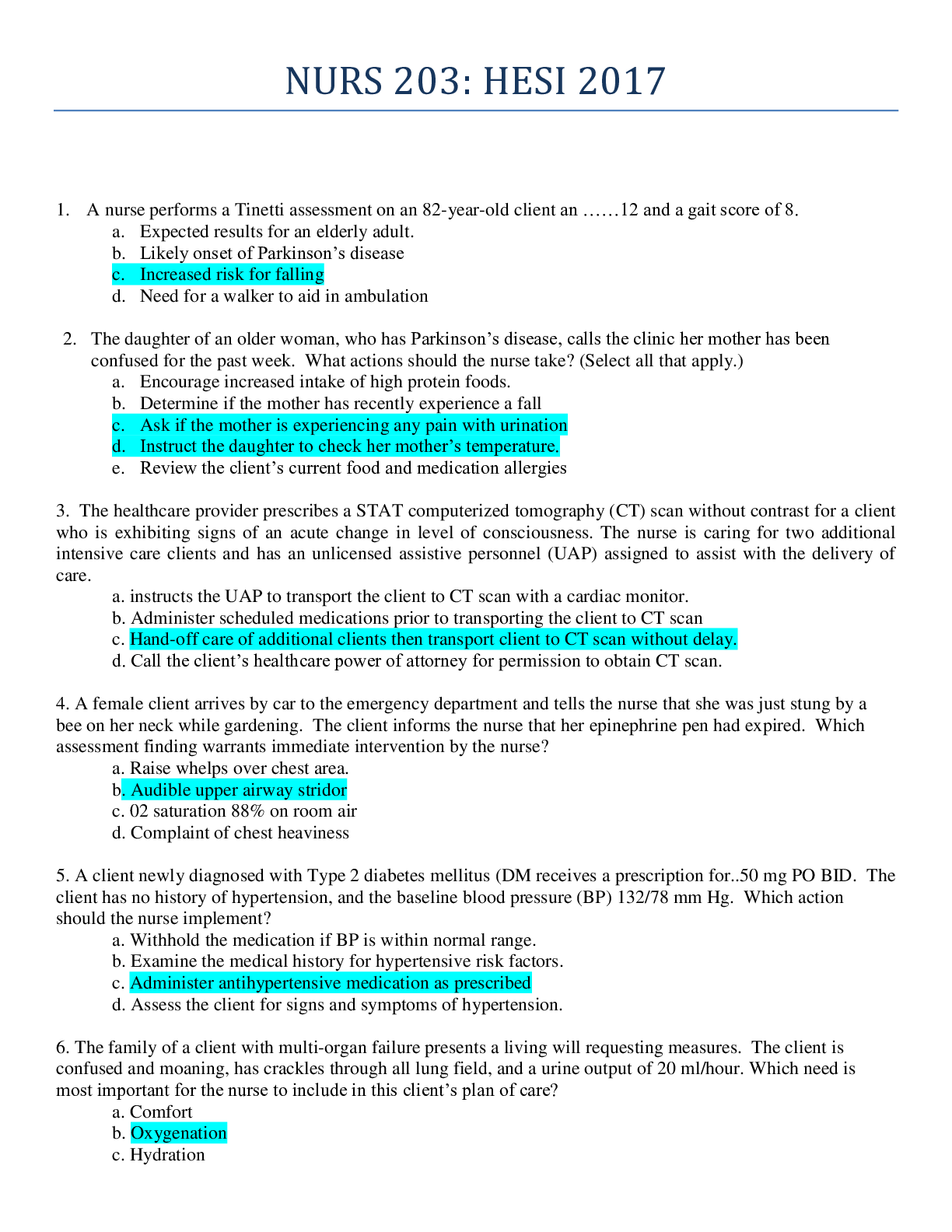
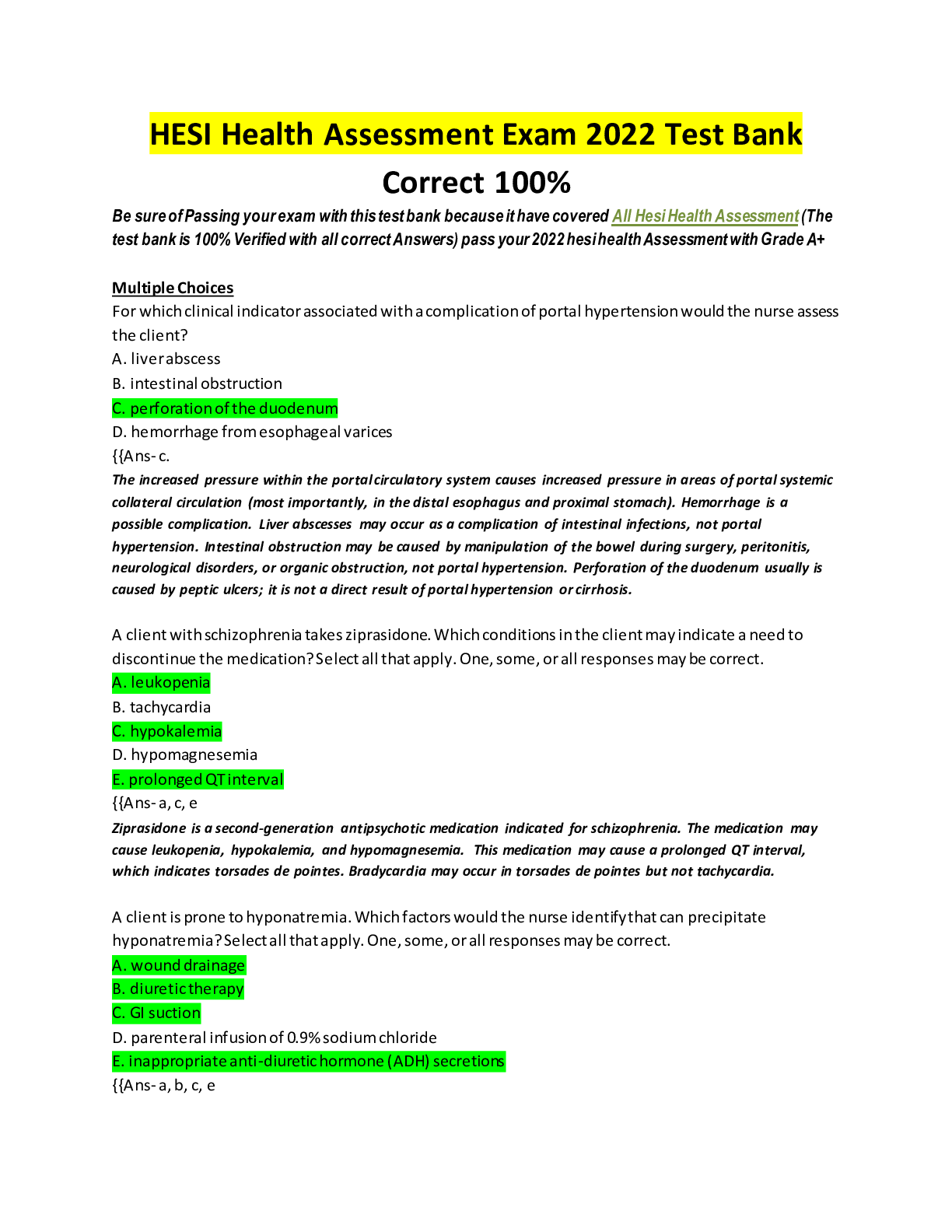
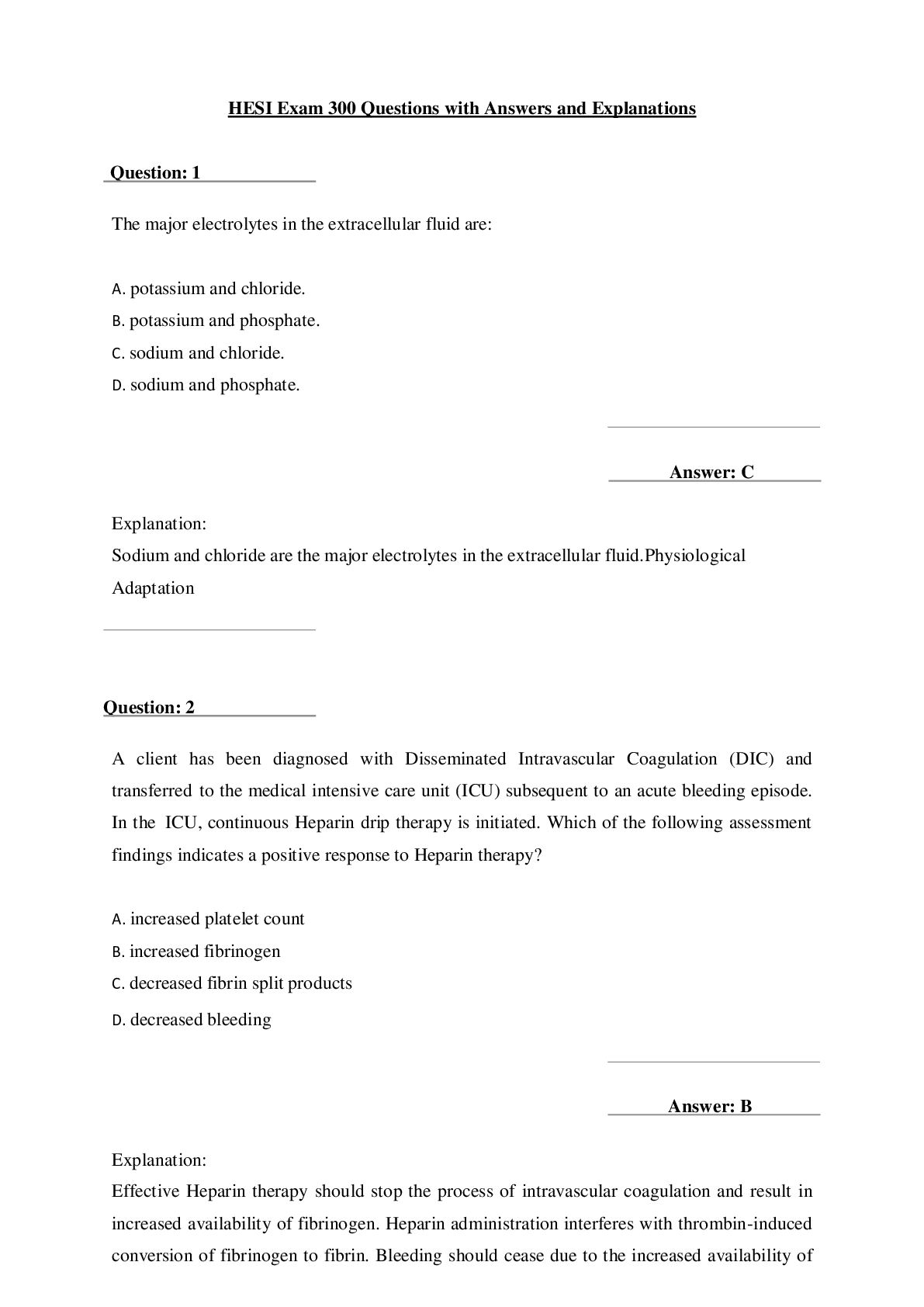


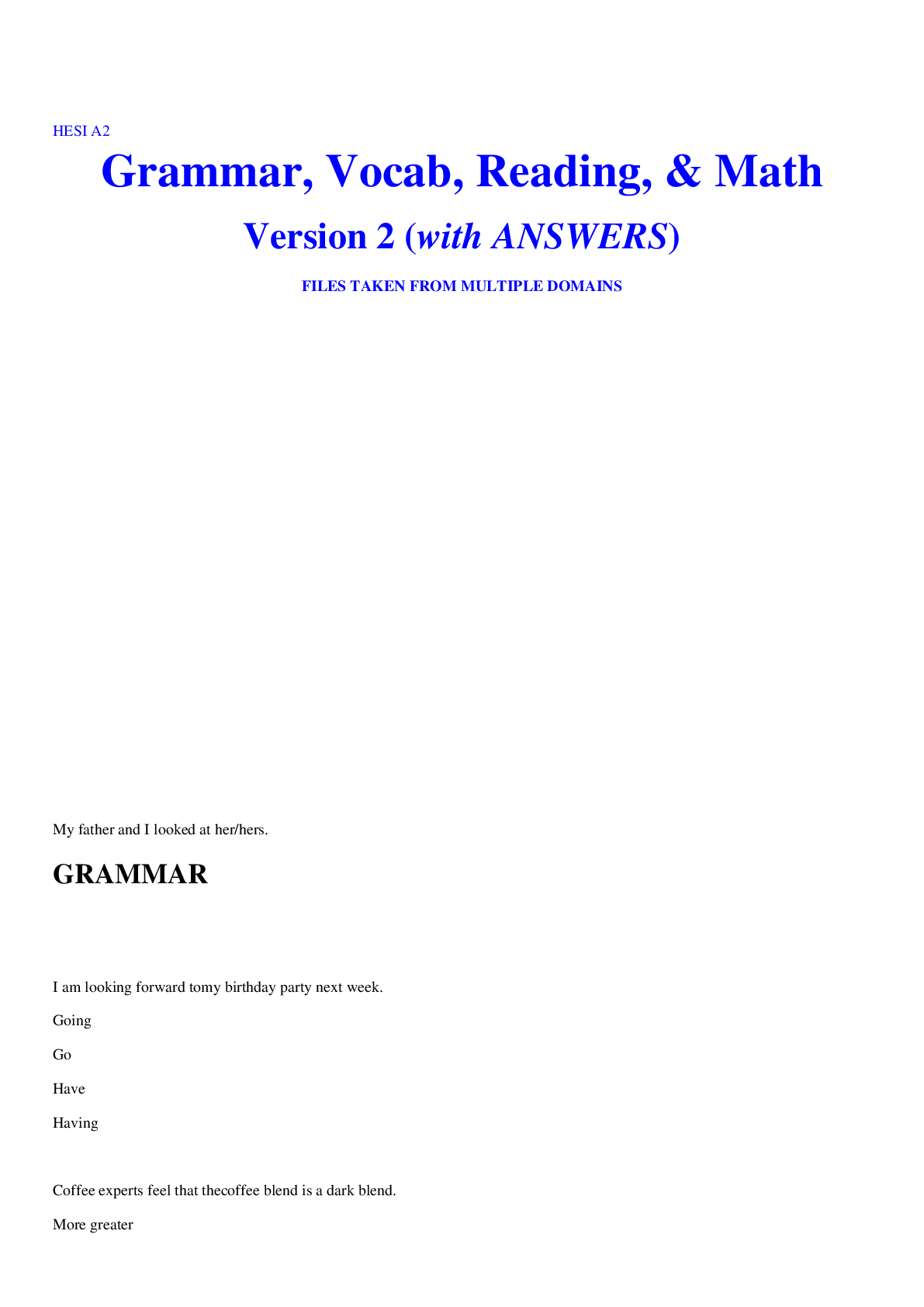

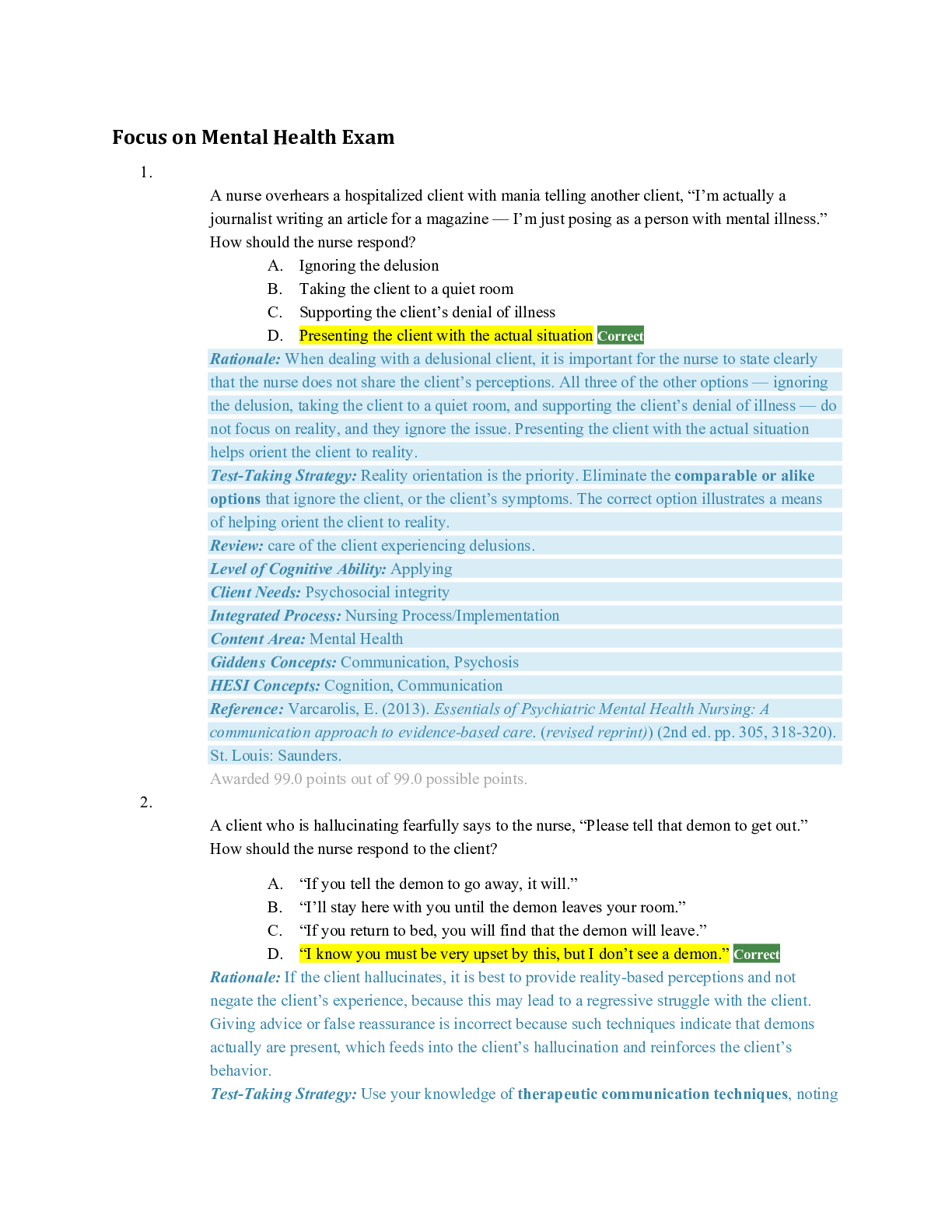
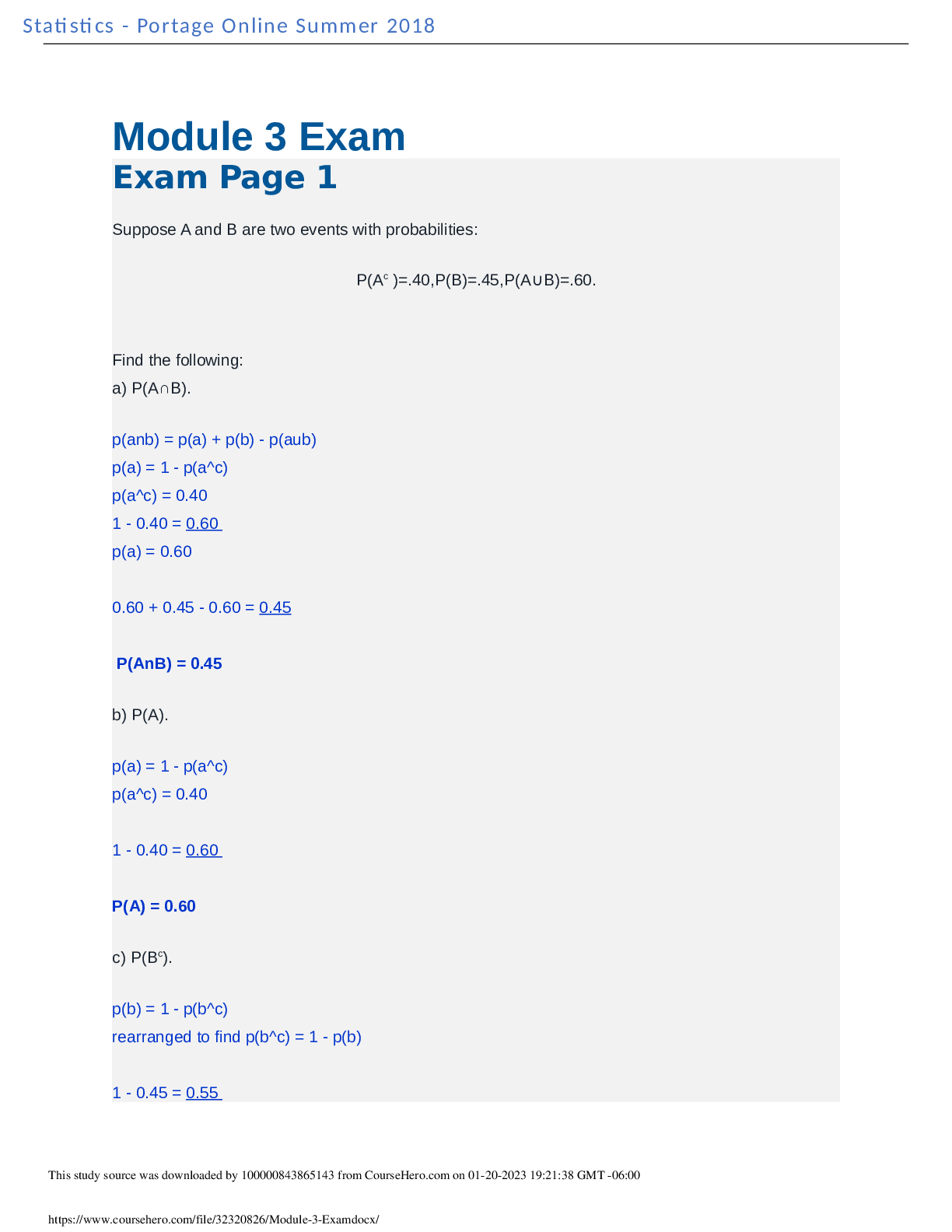
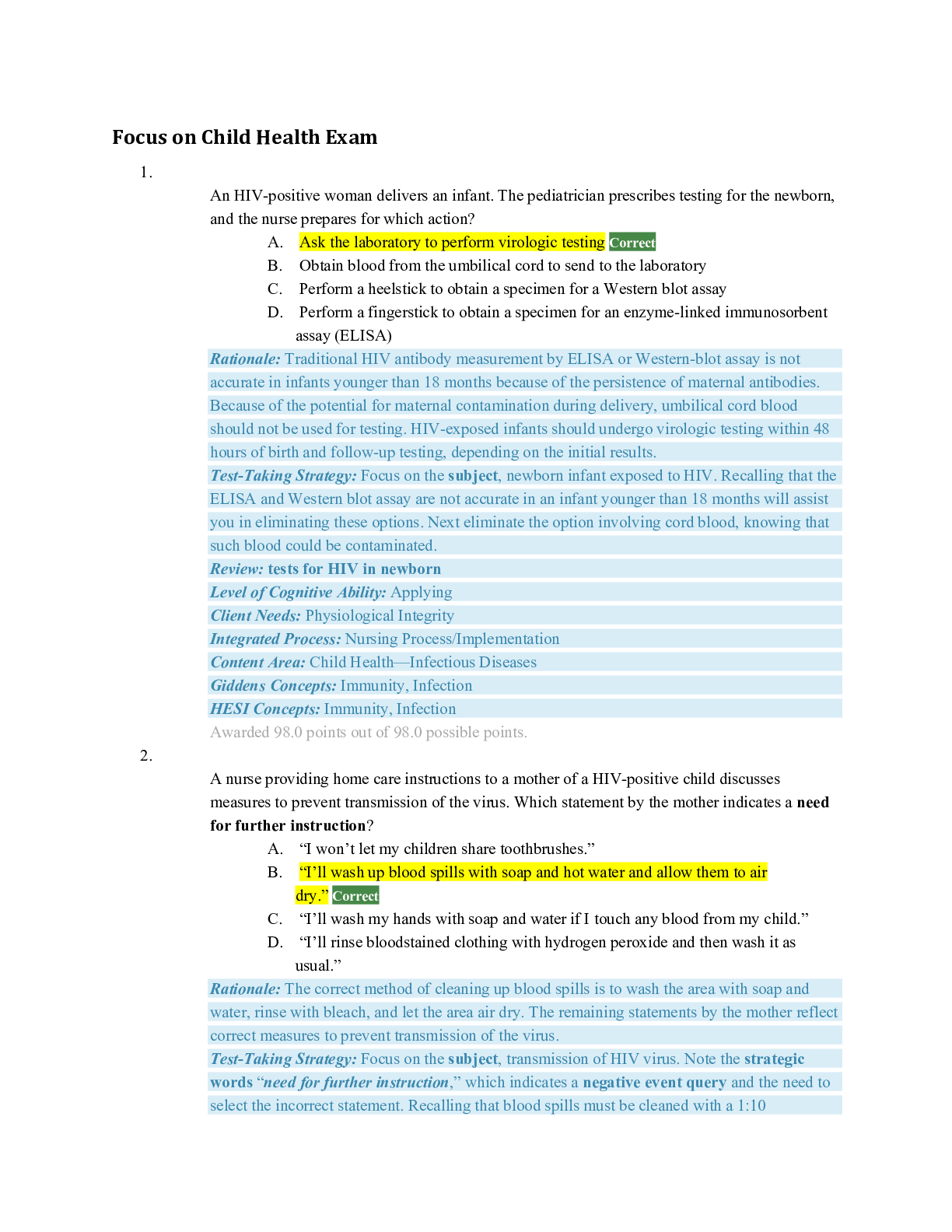
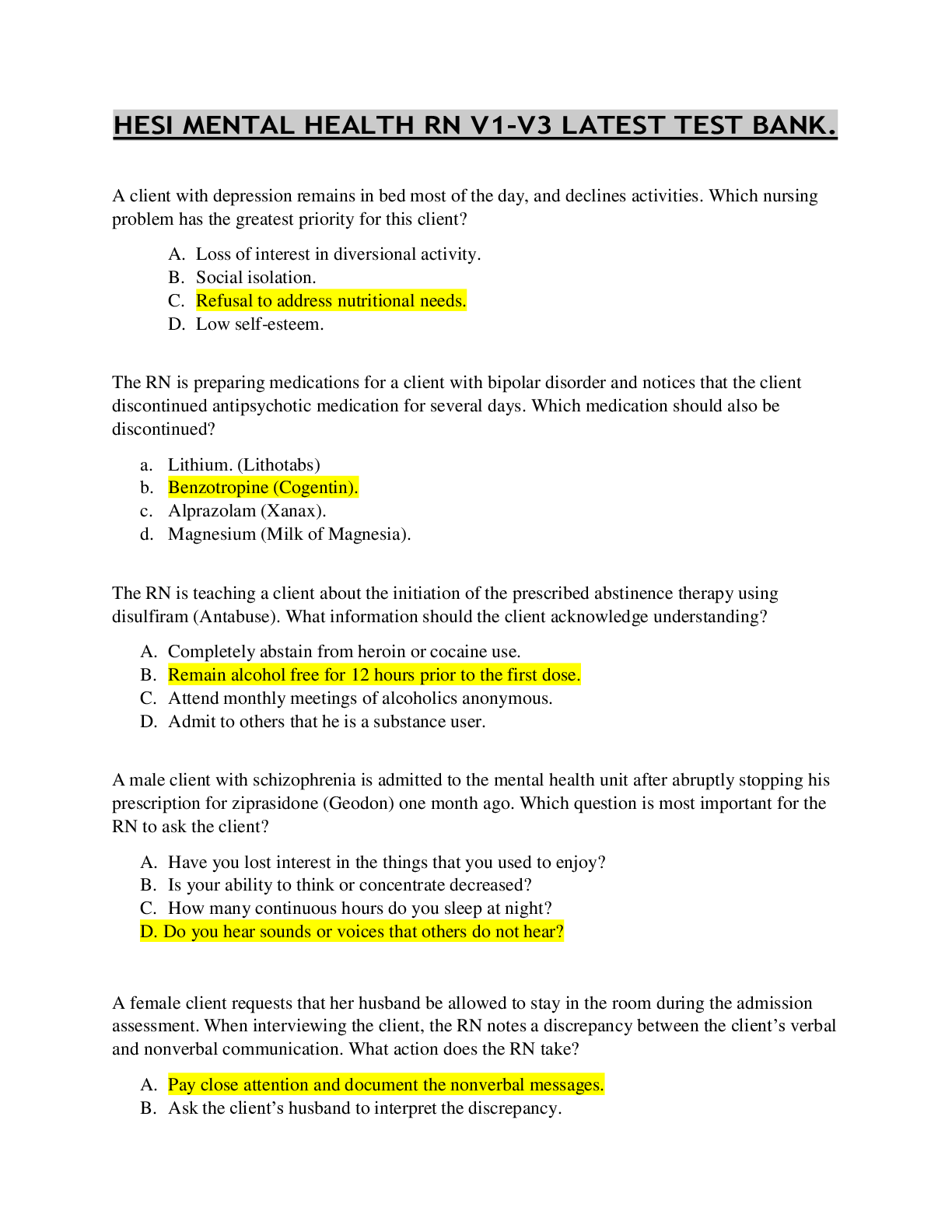
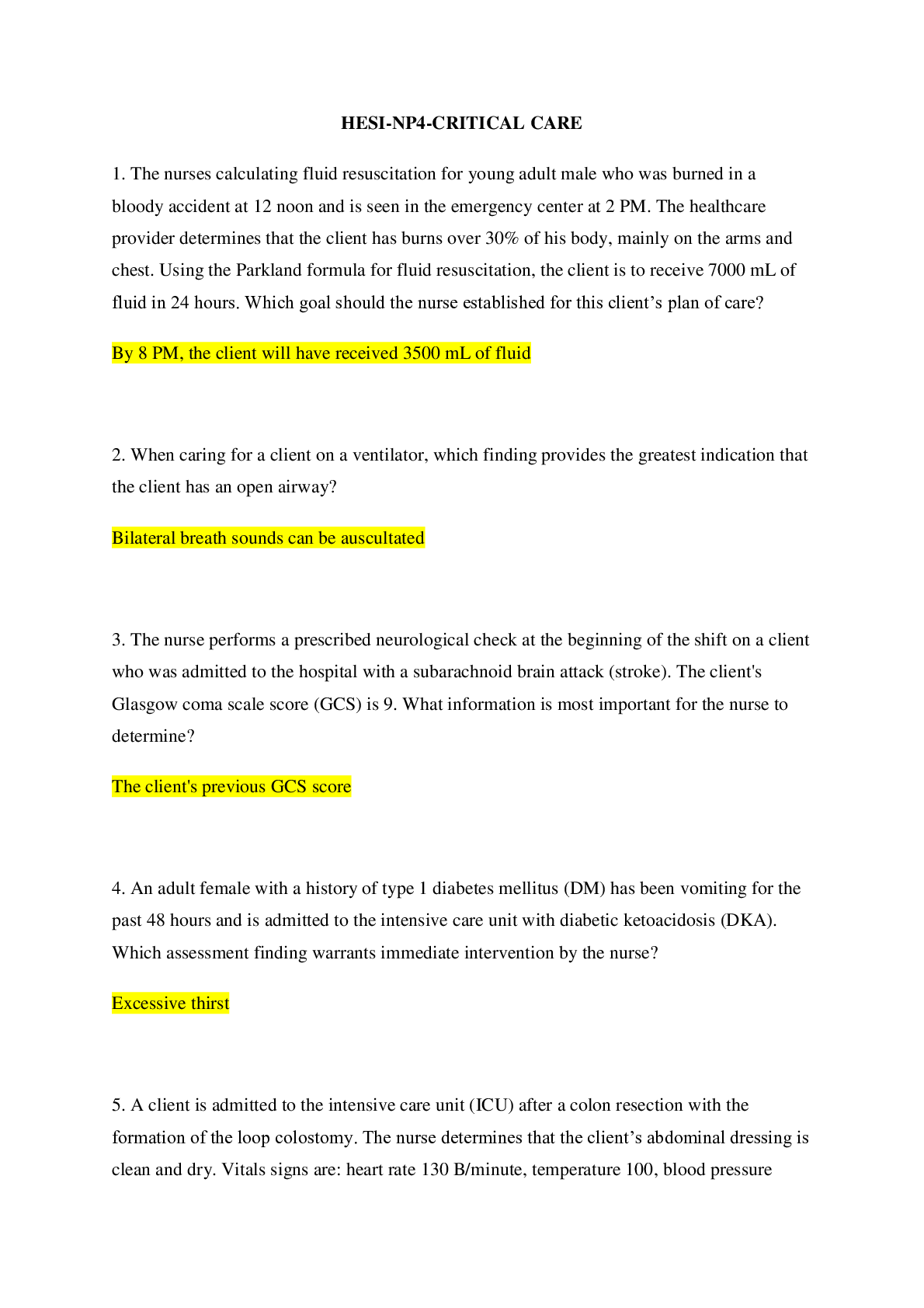

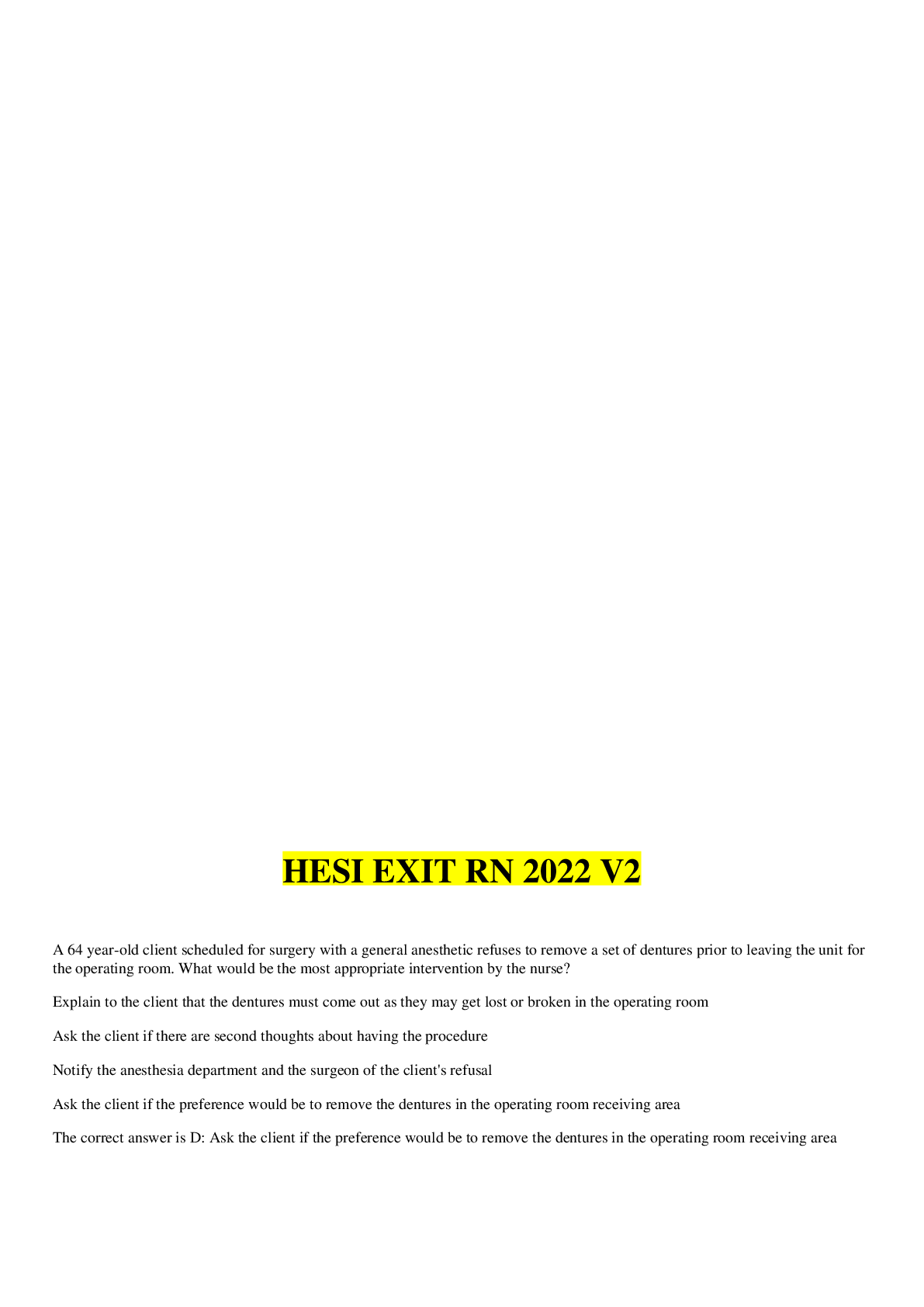
.png)
